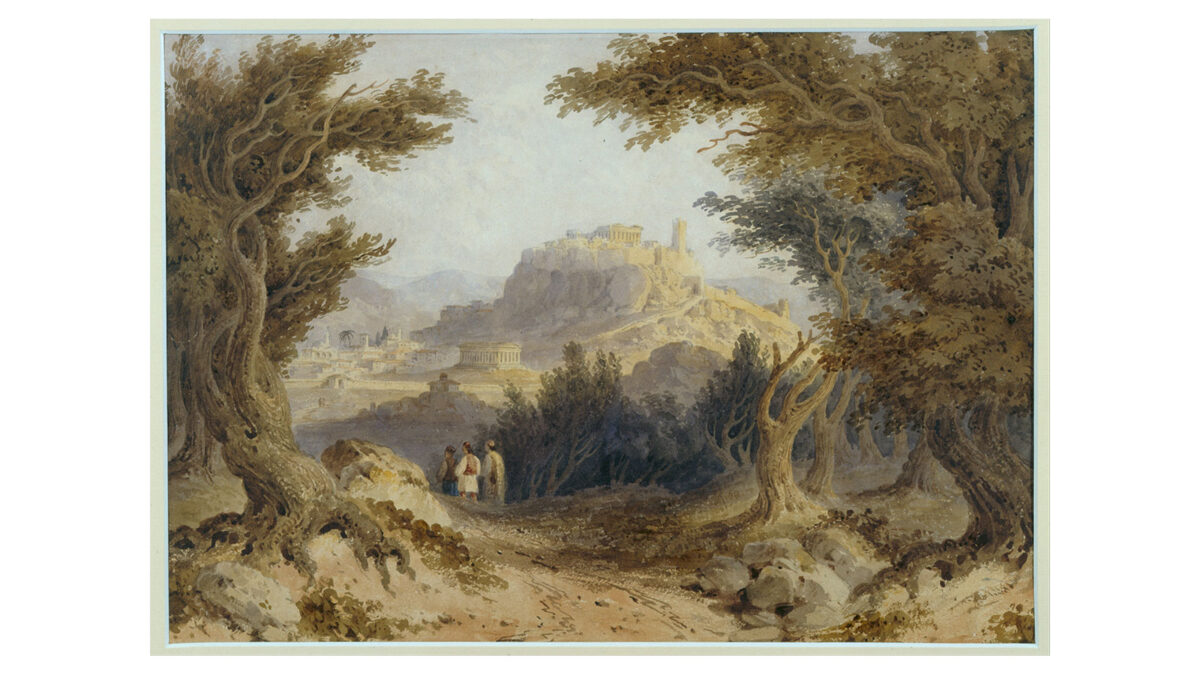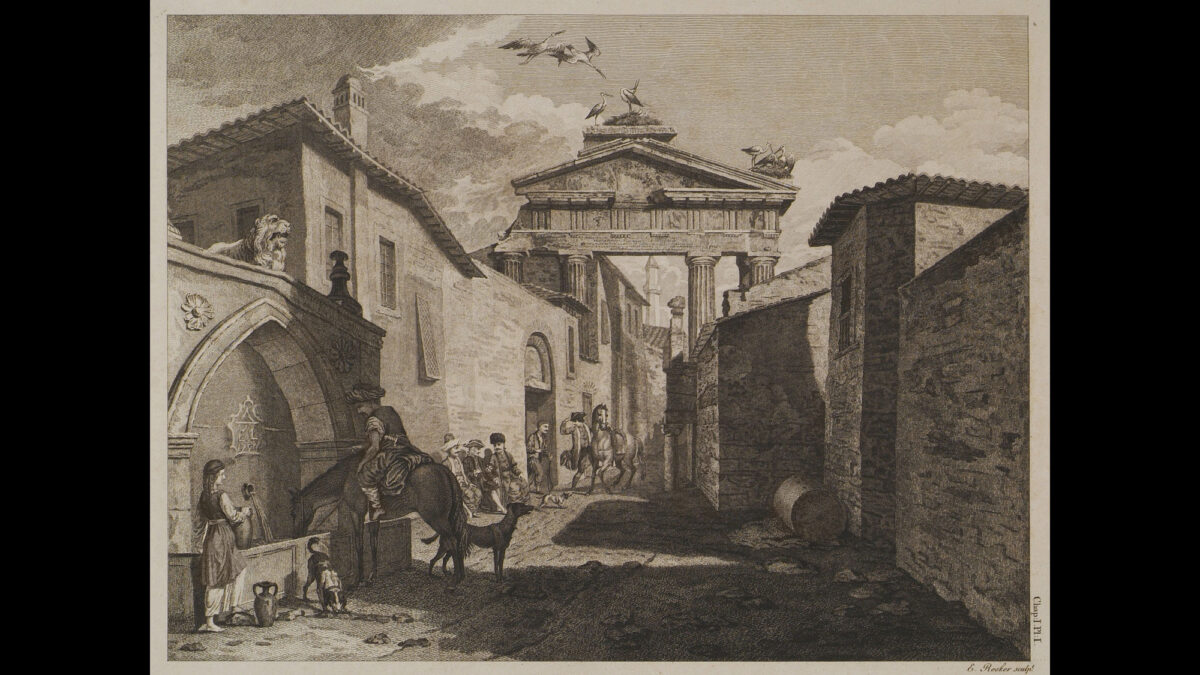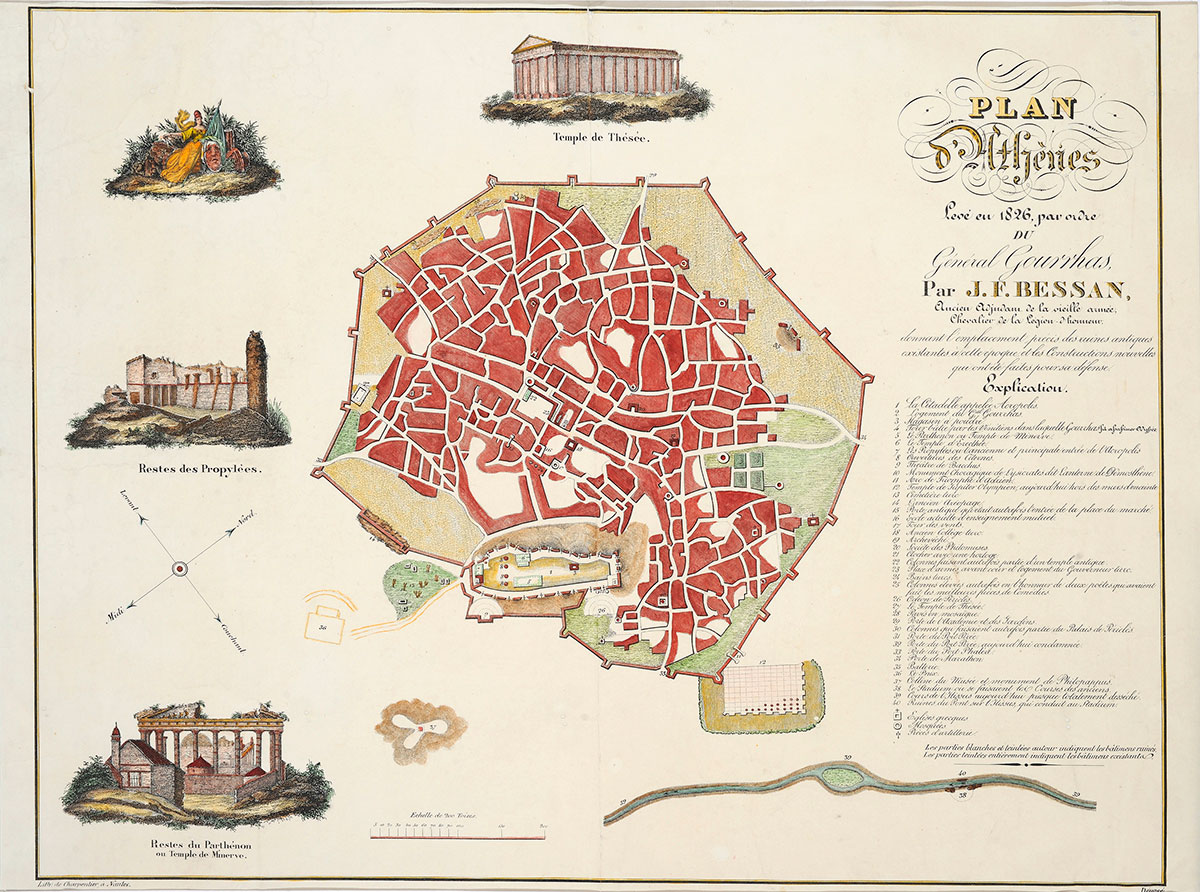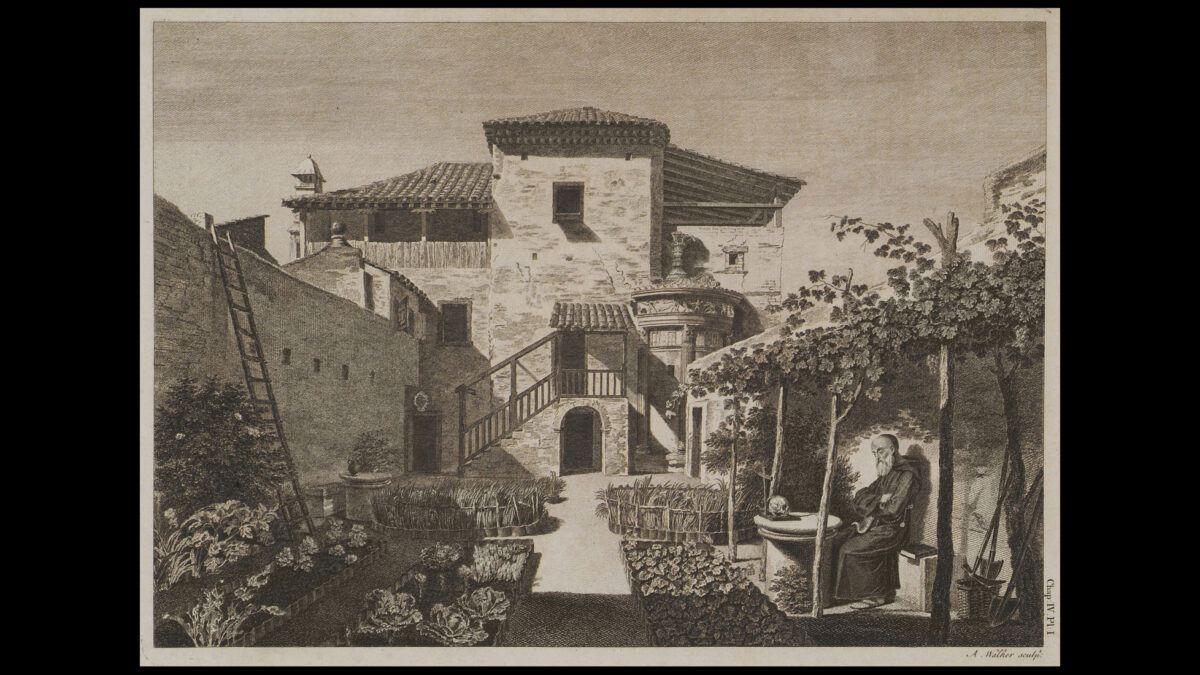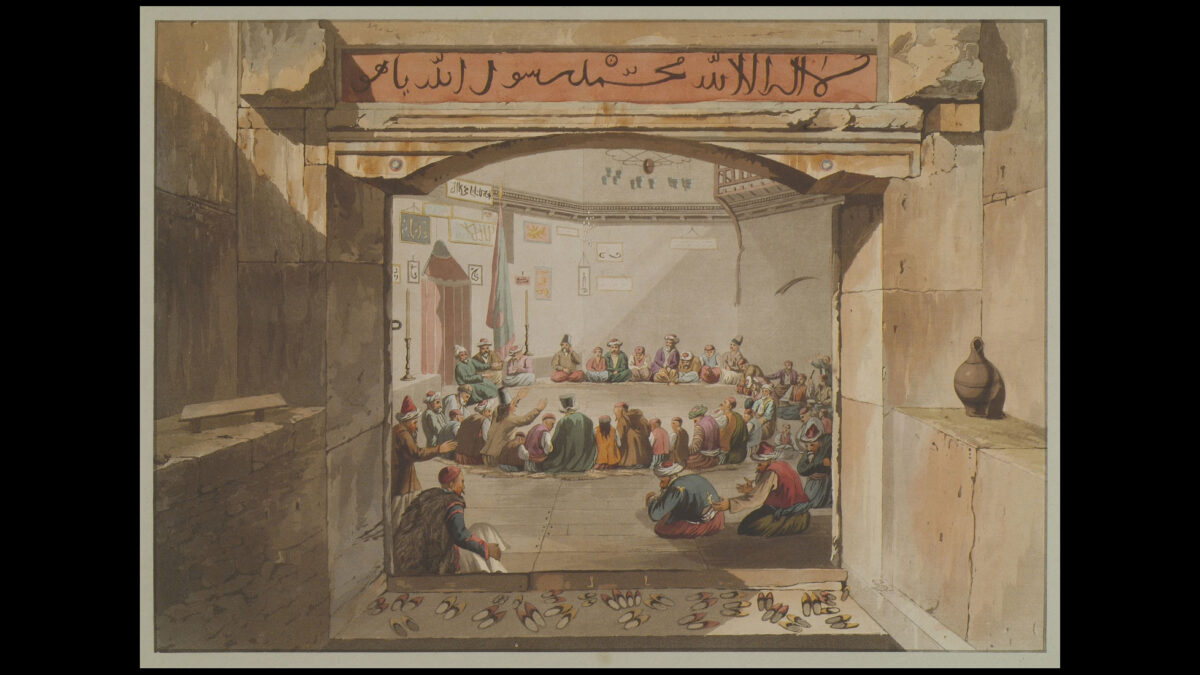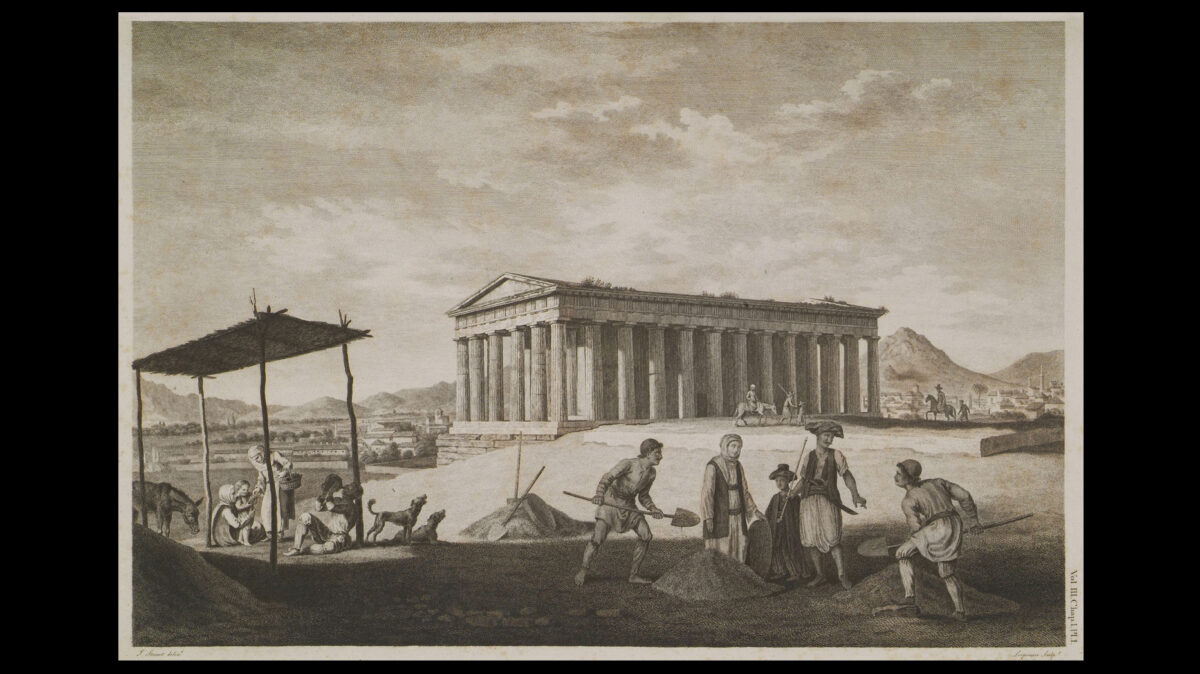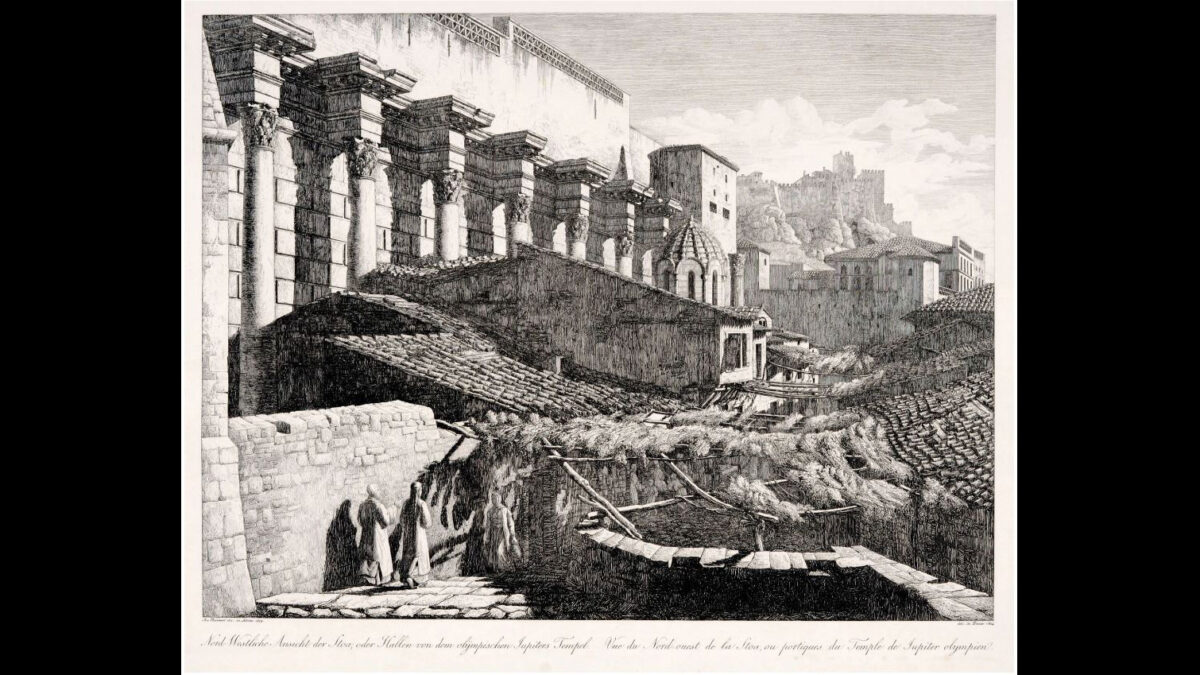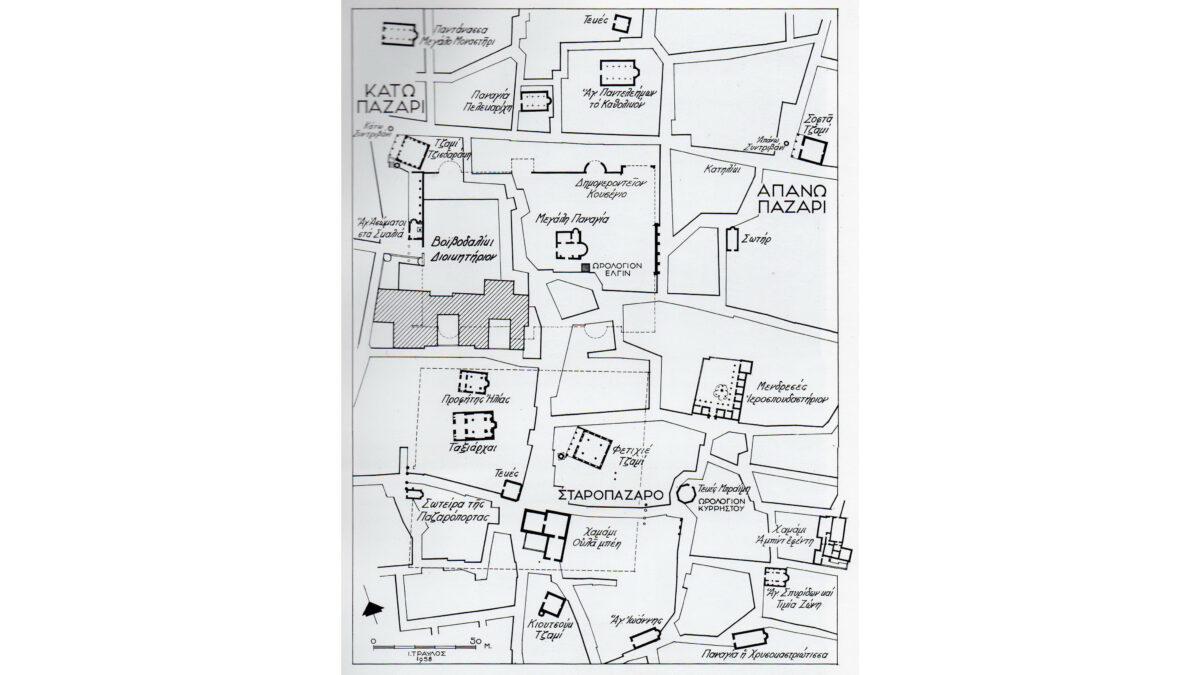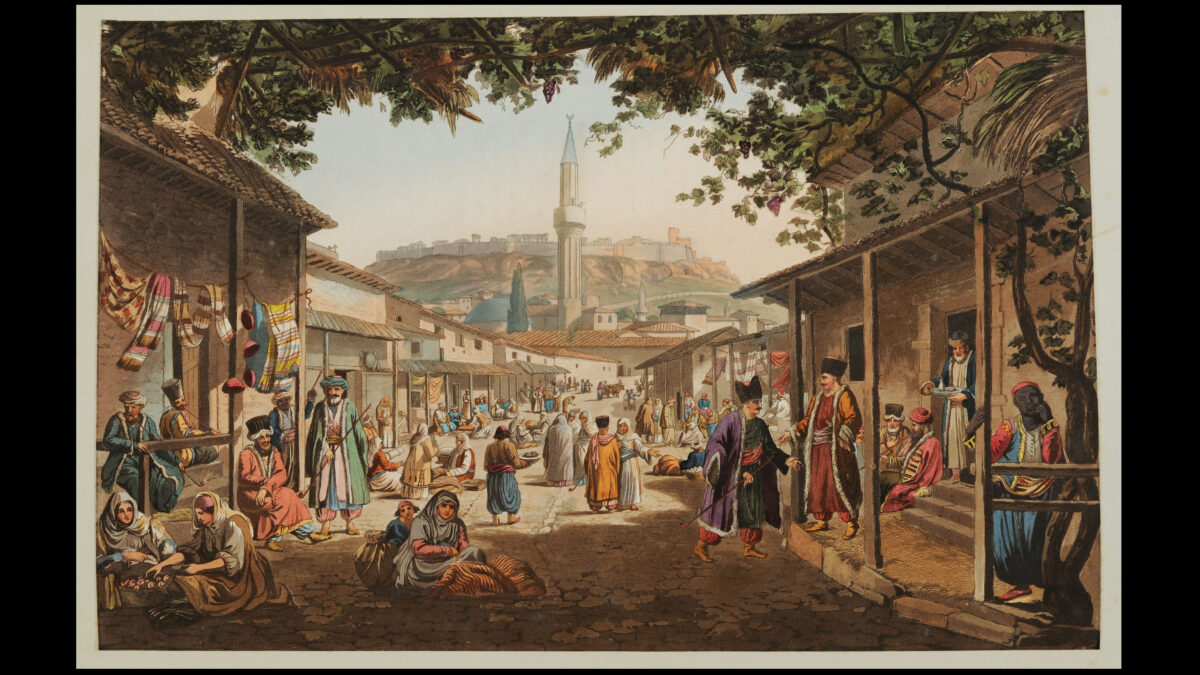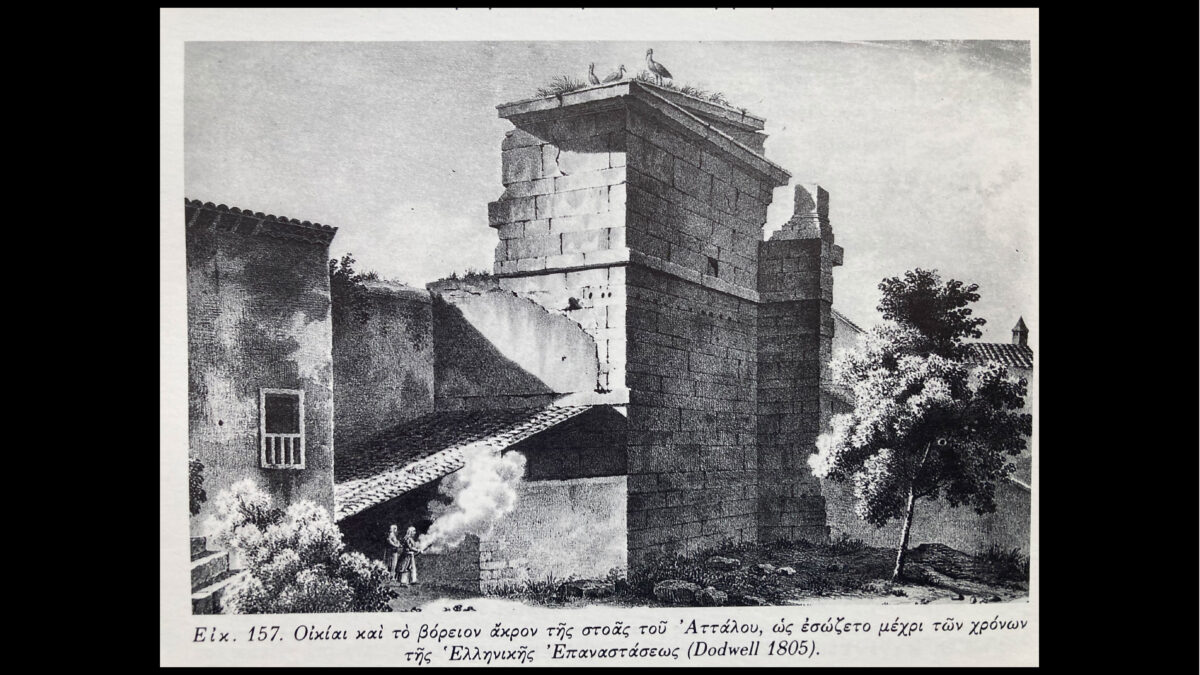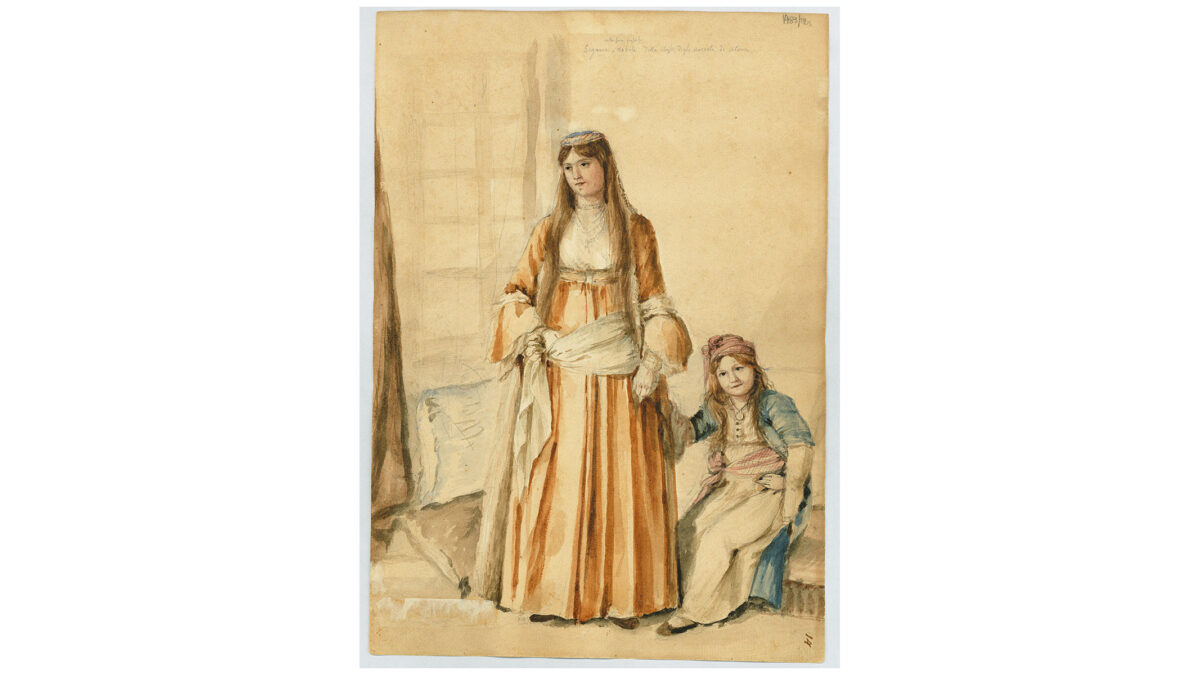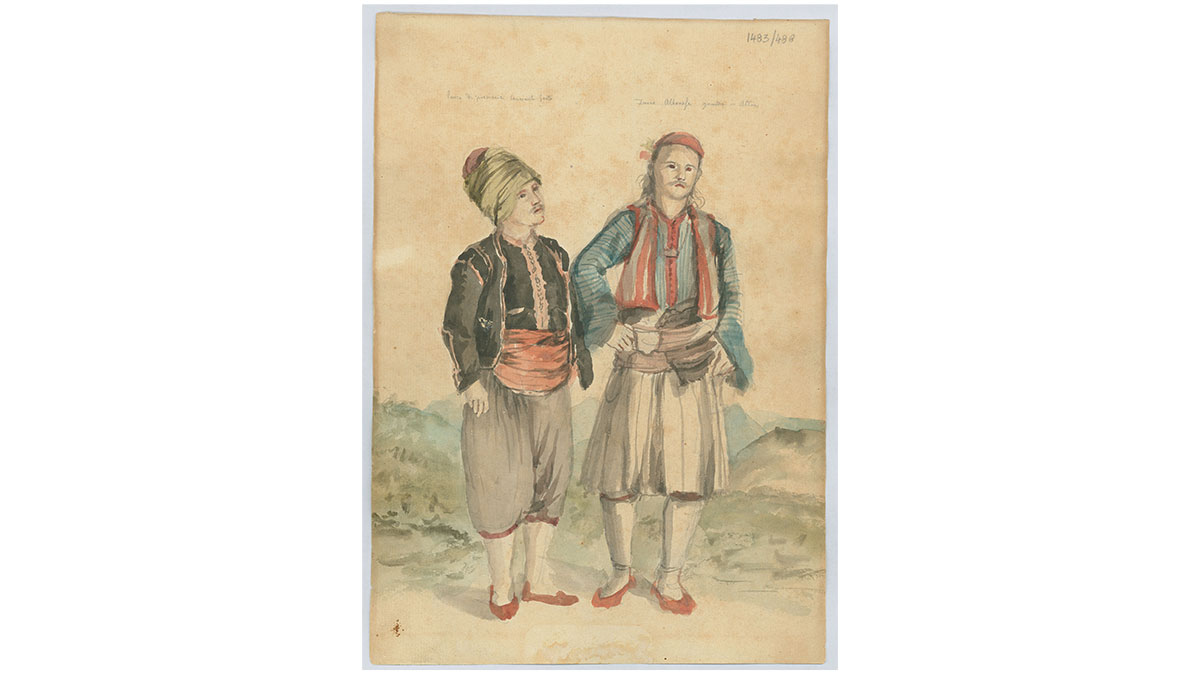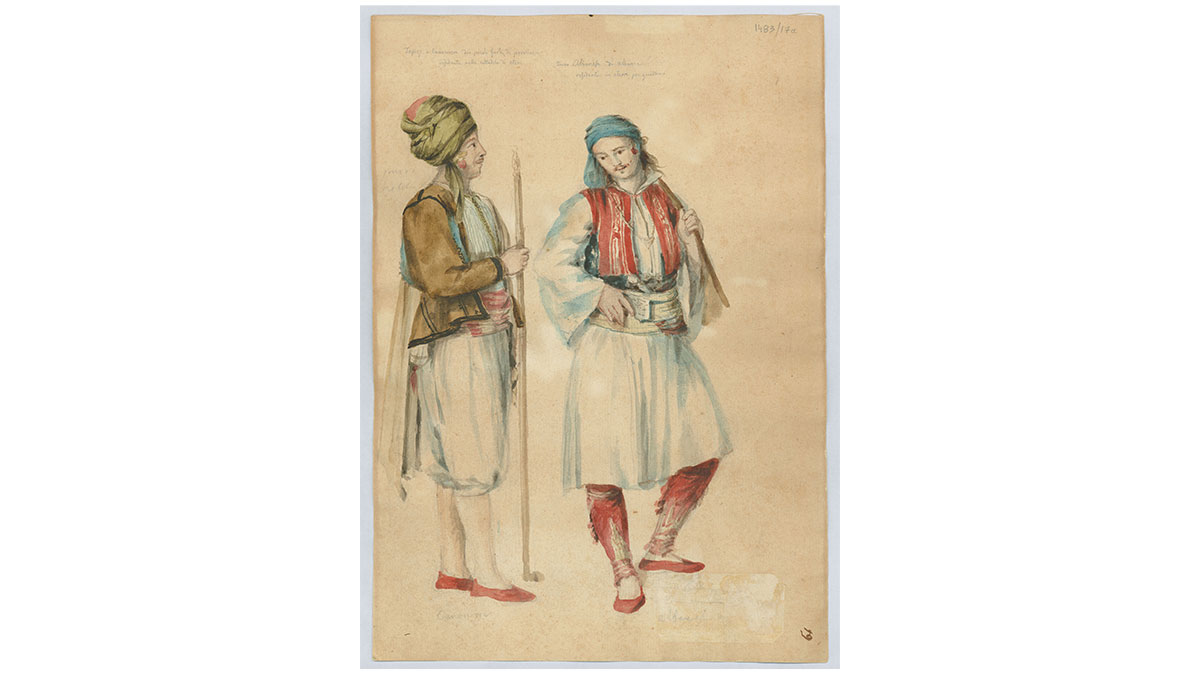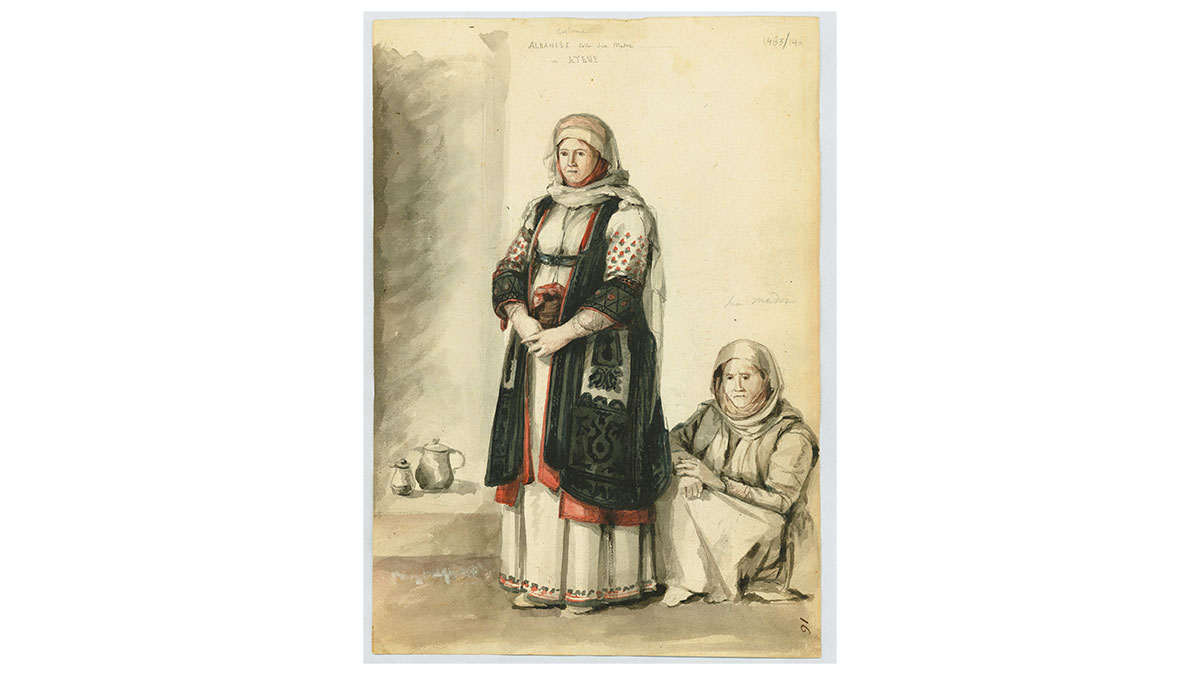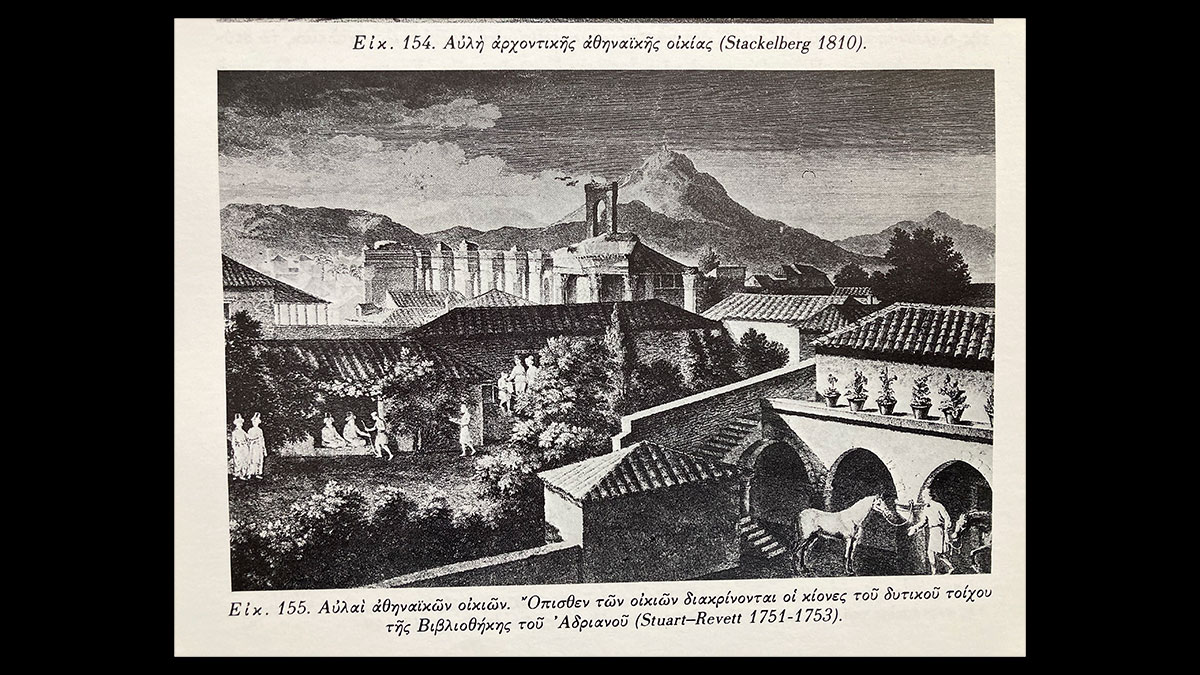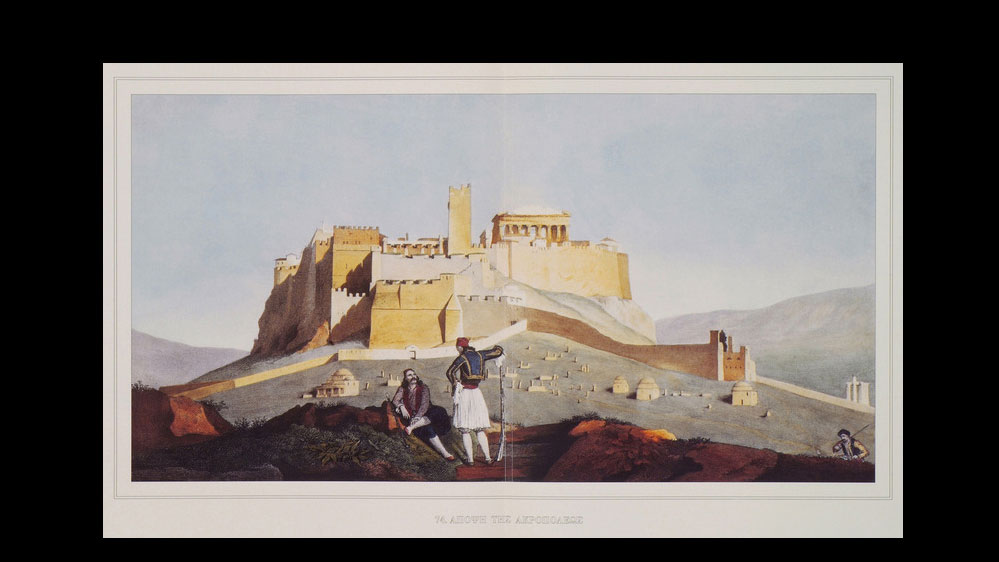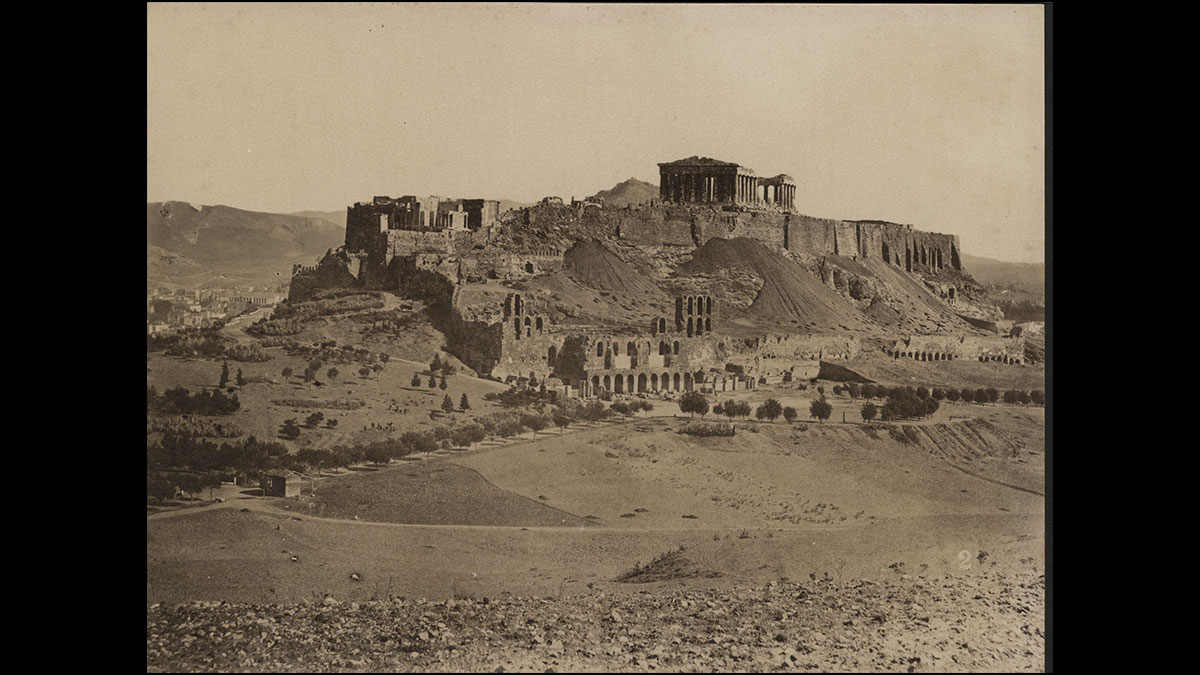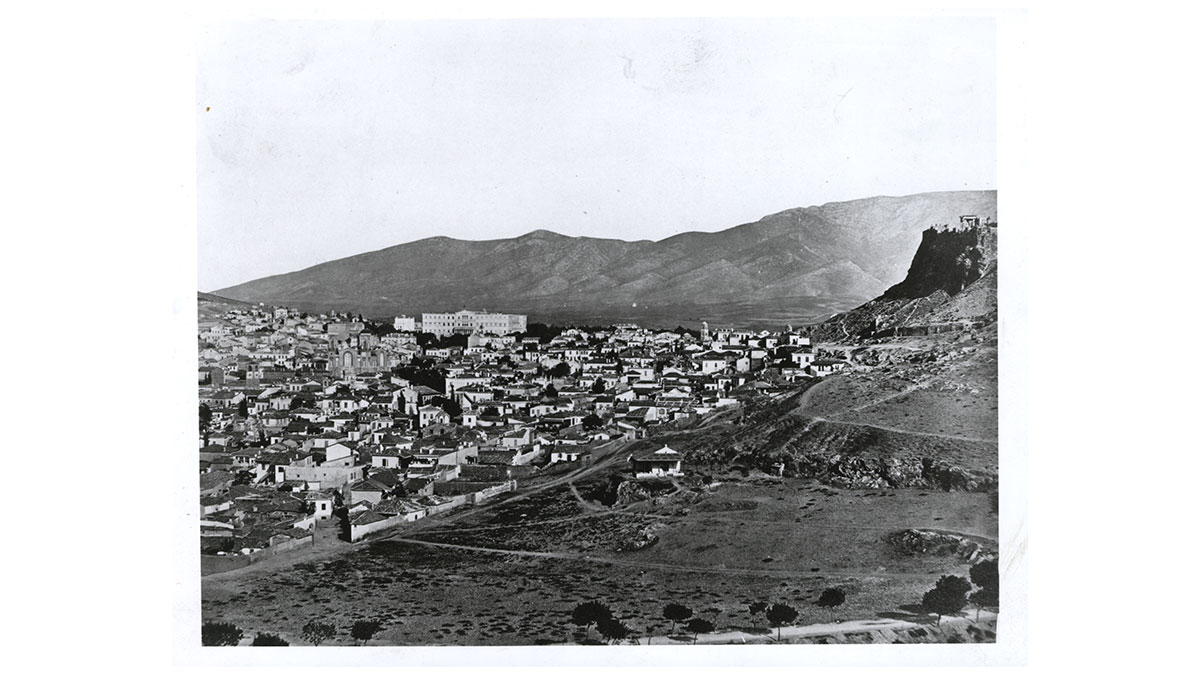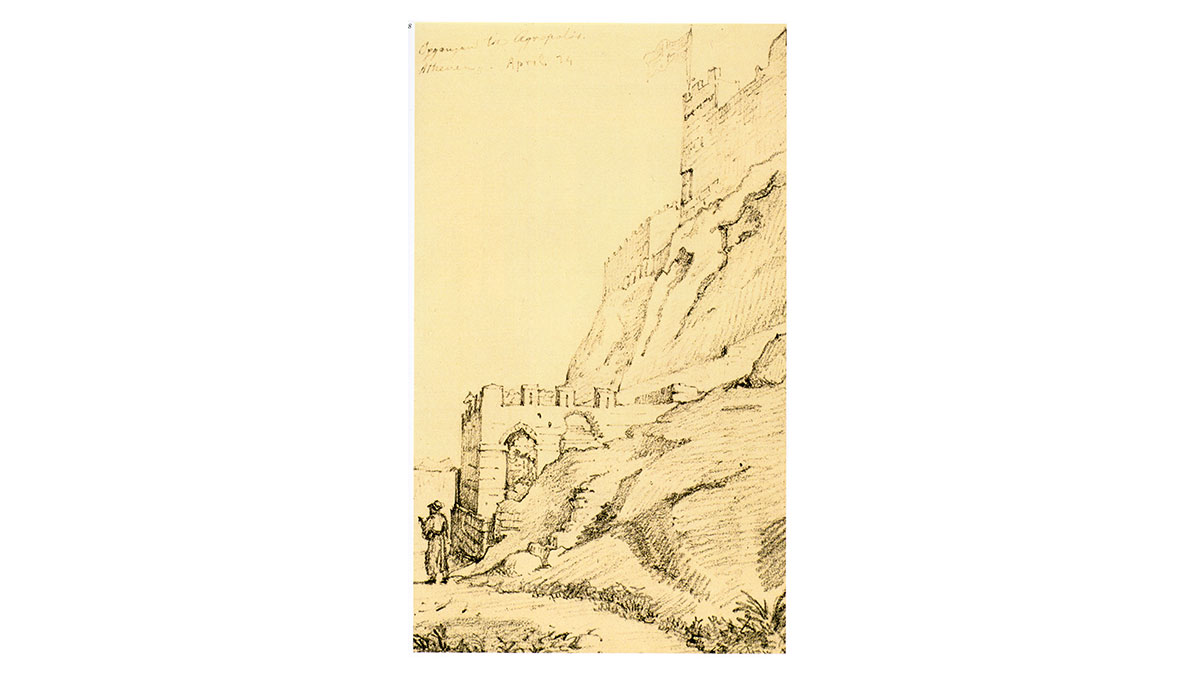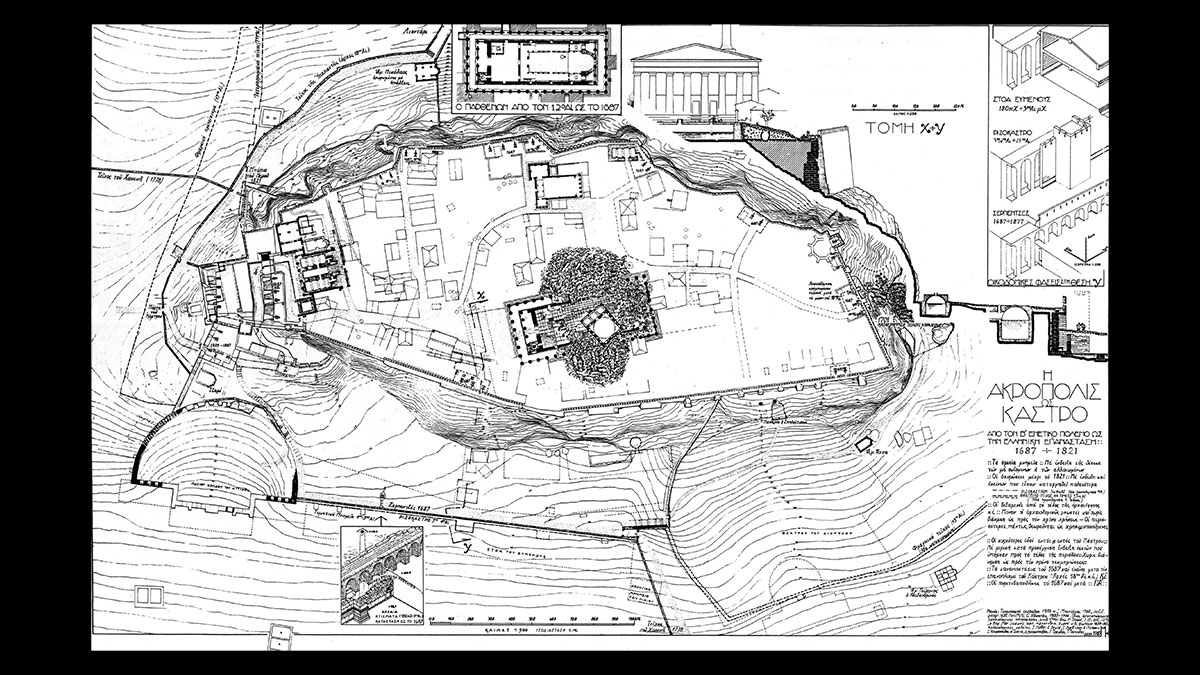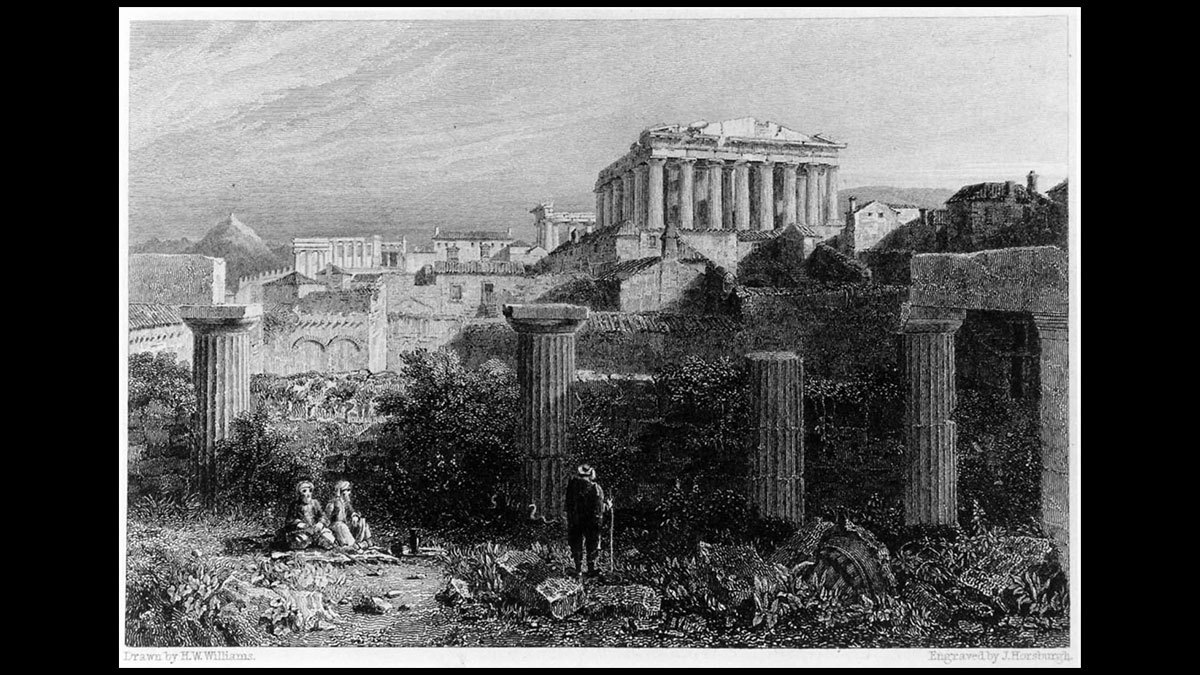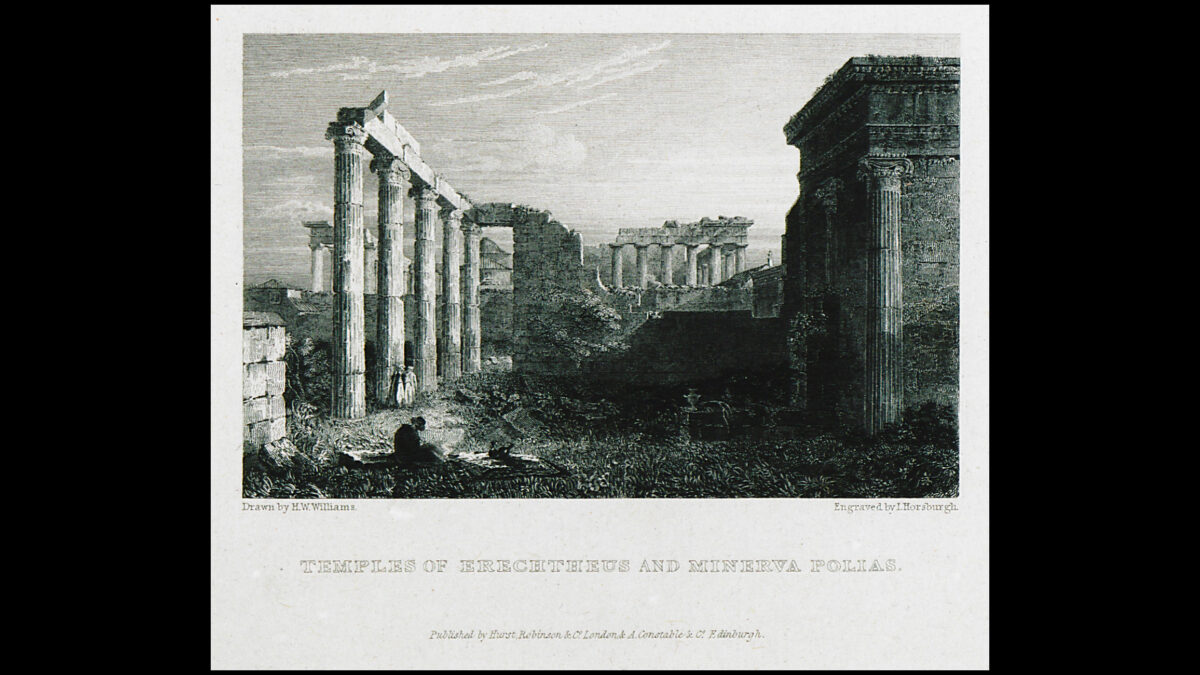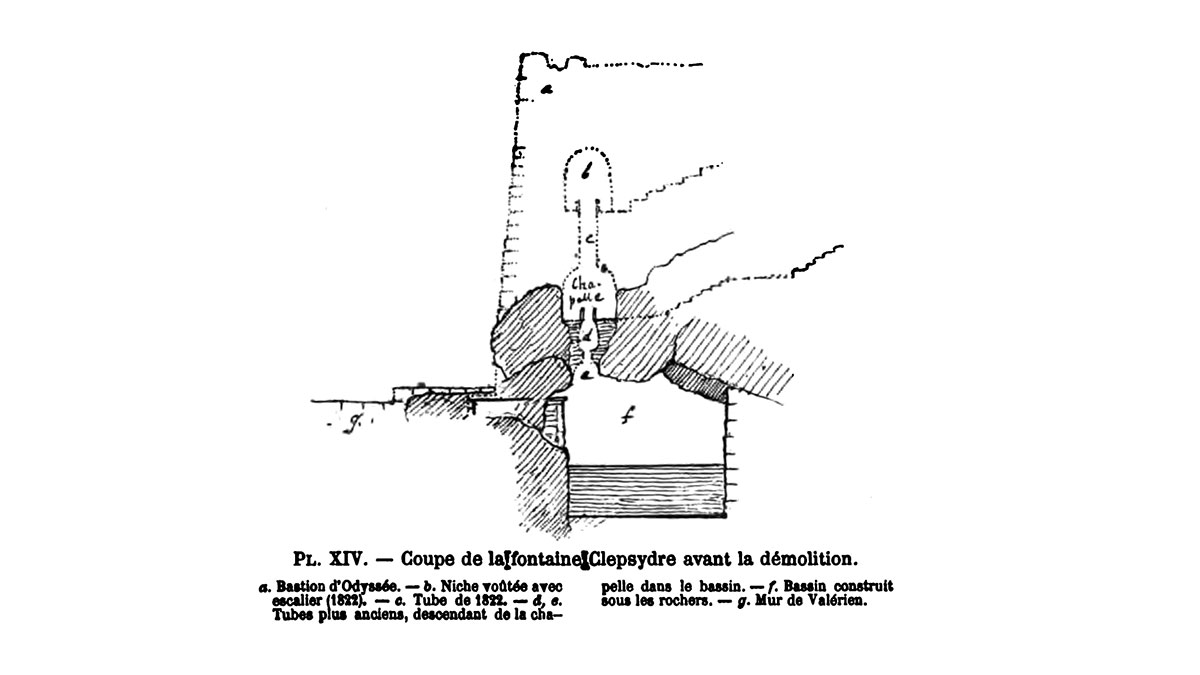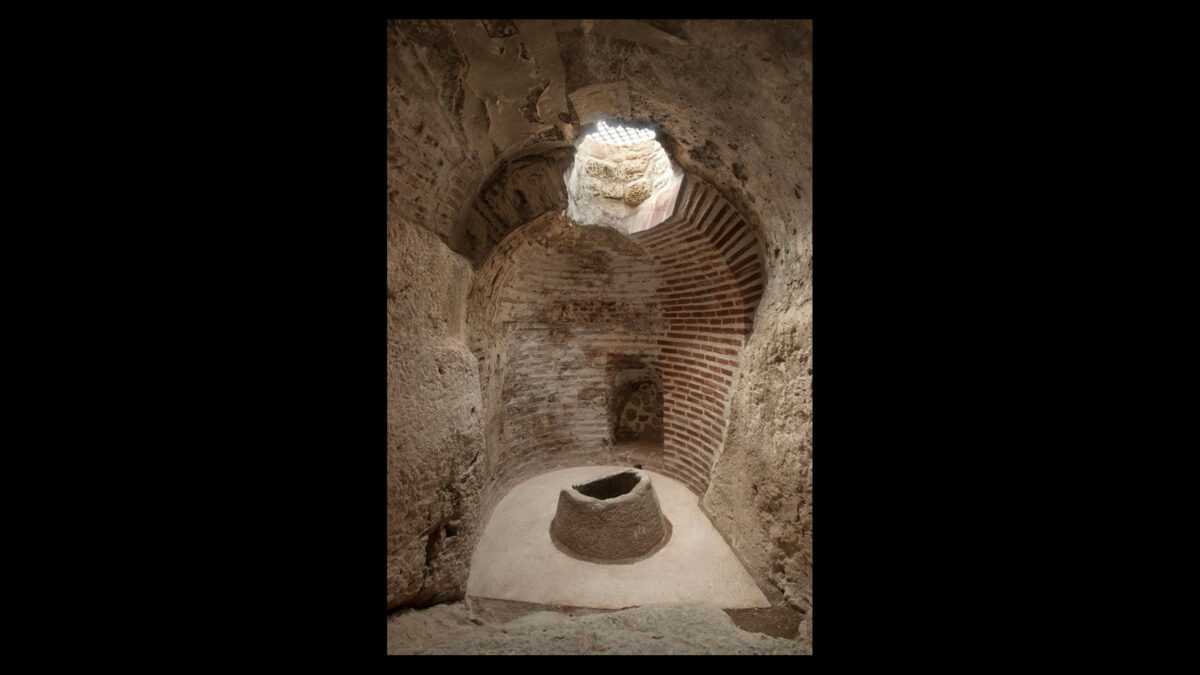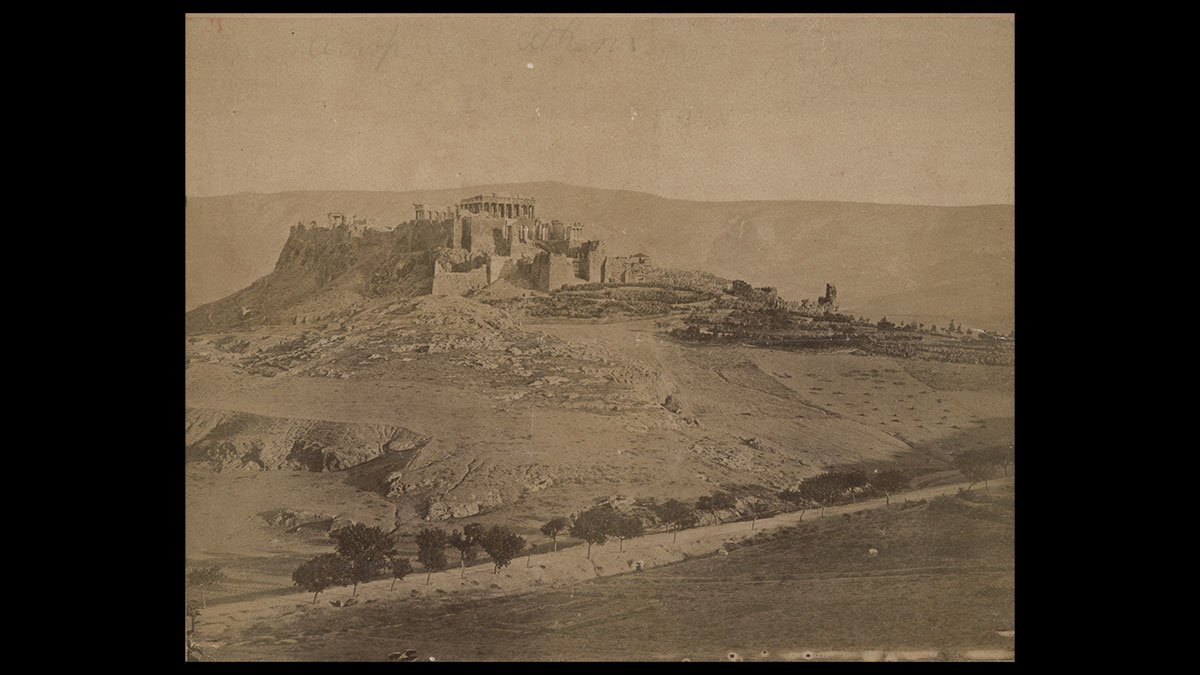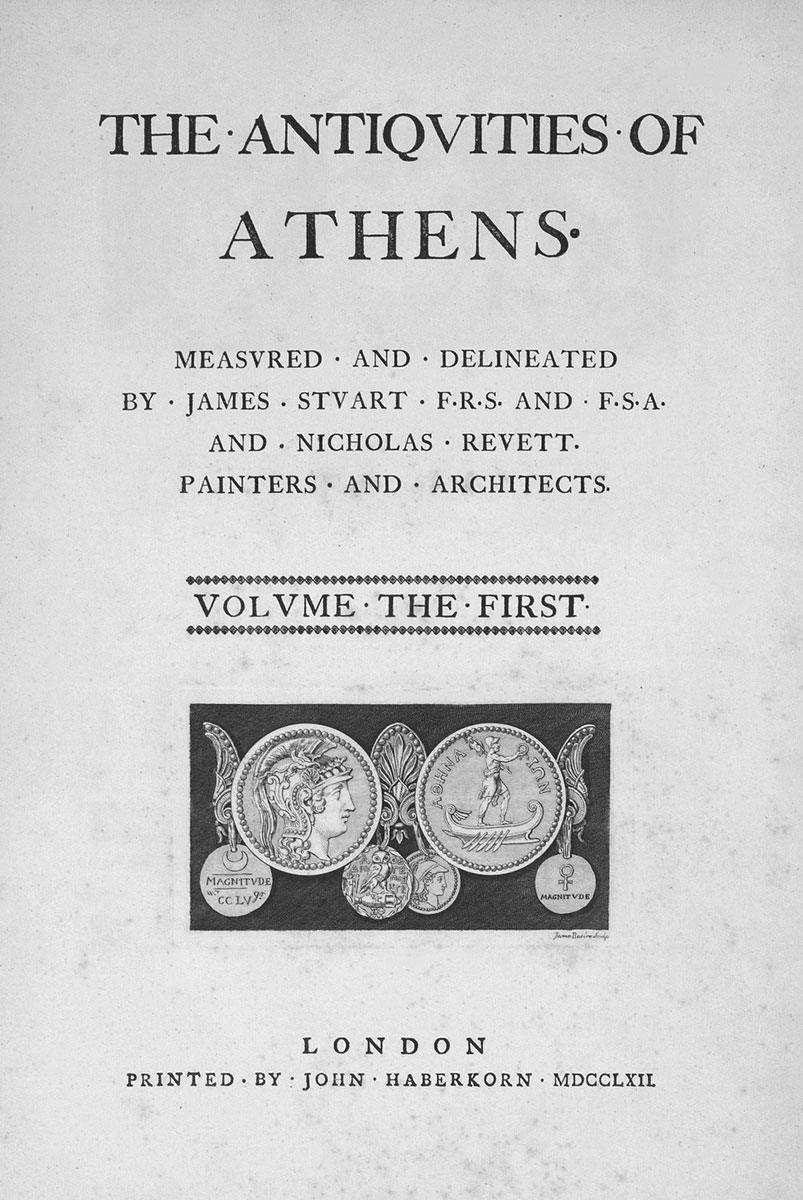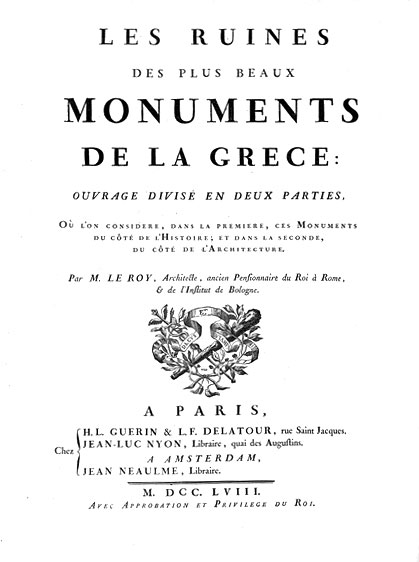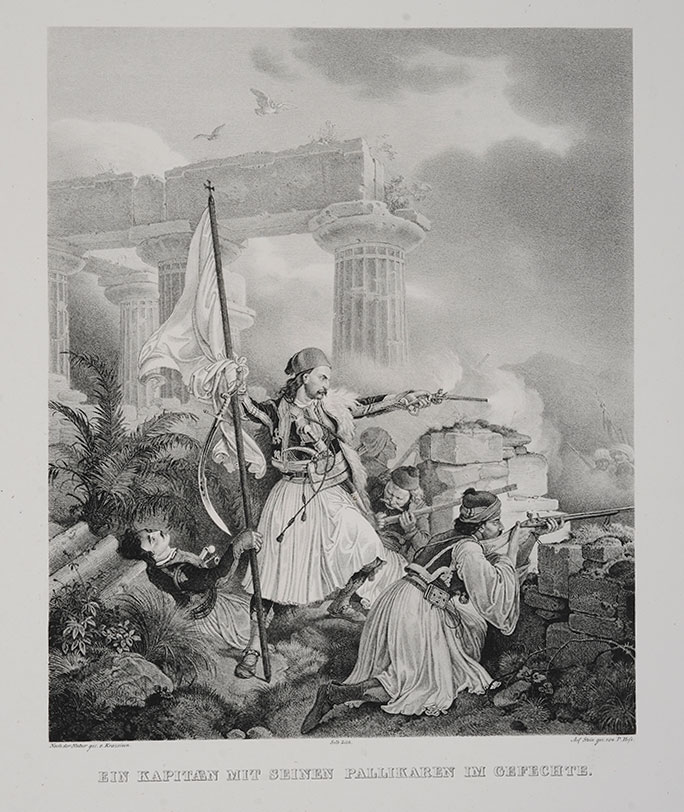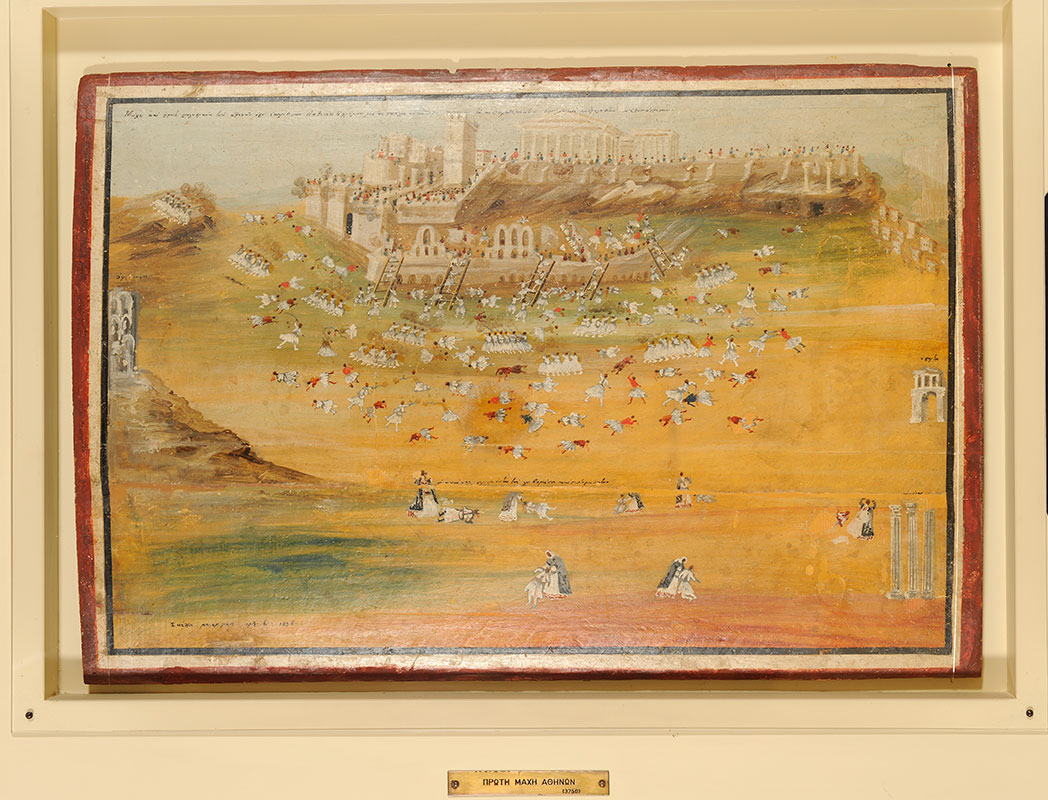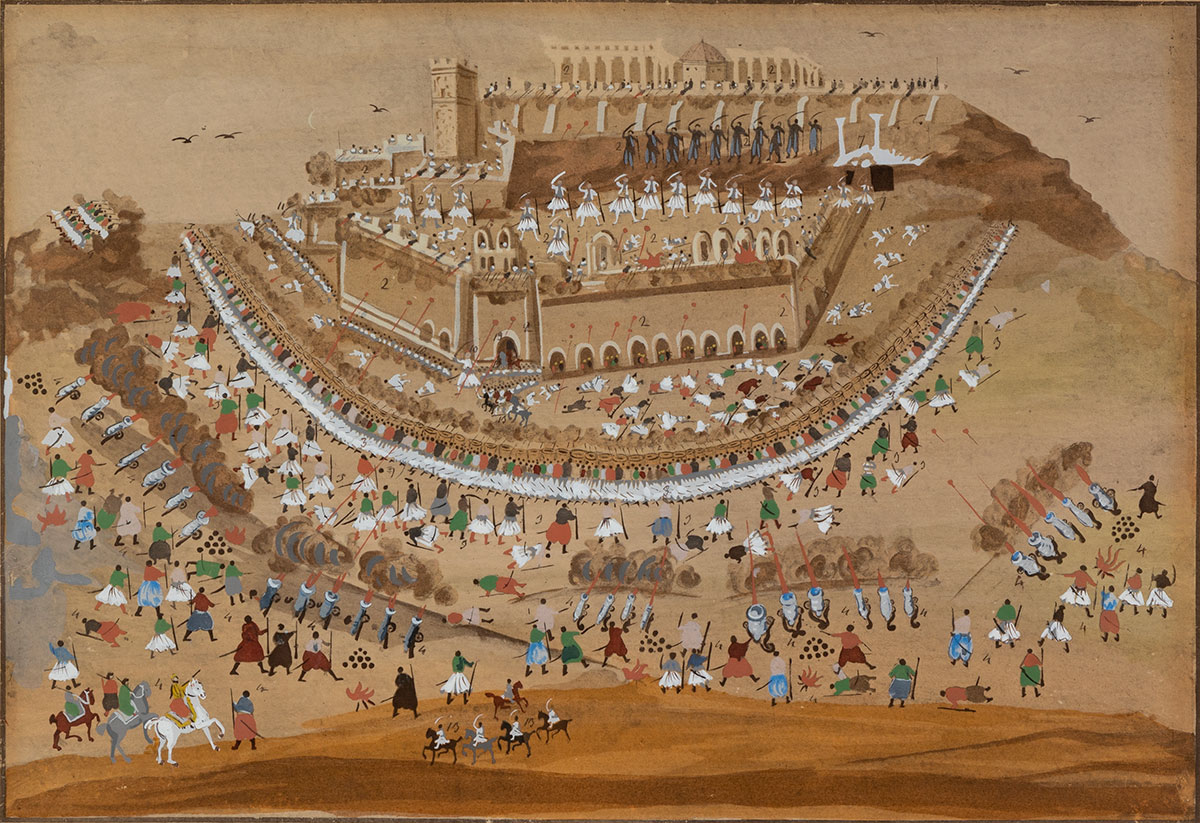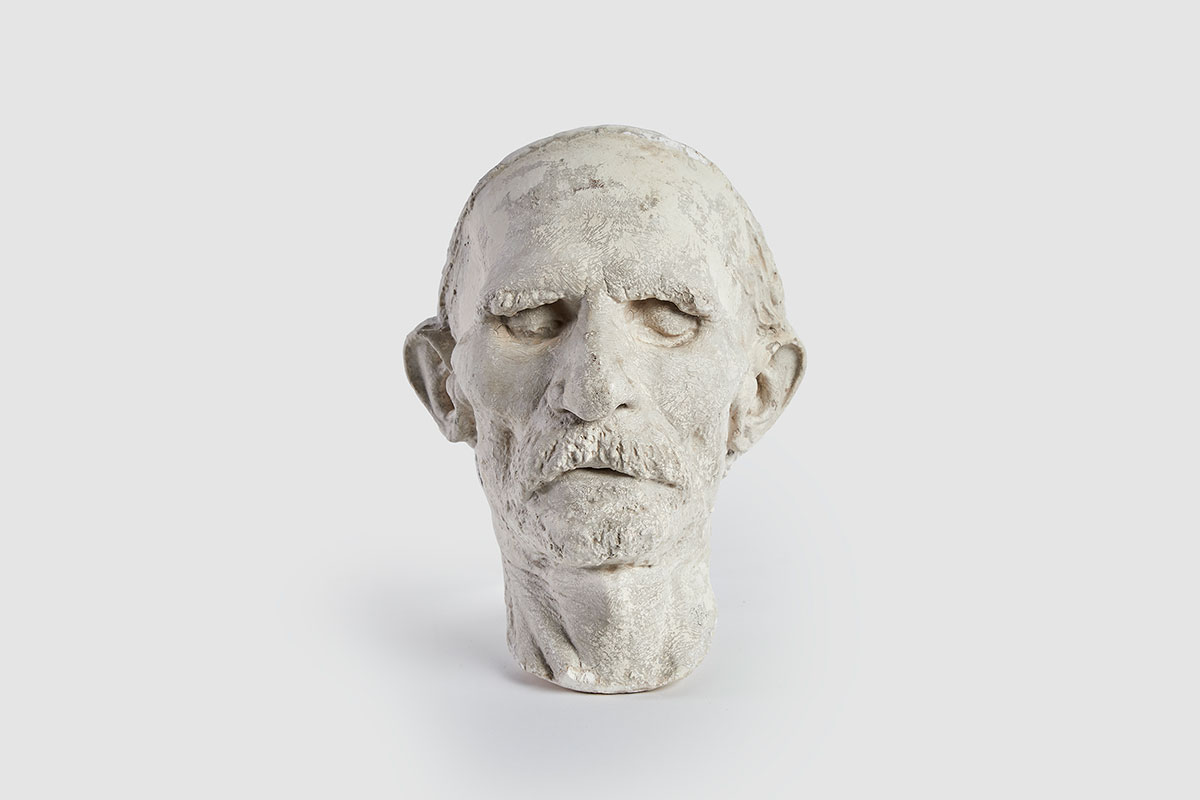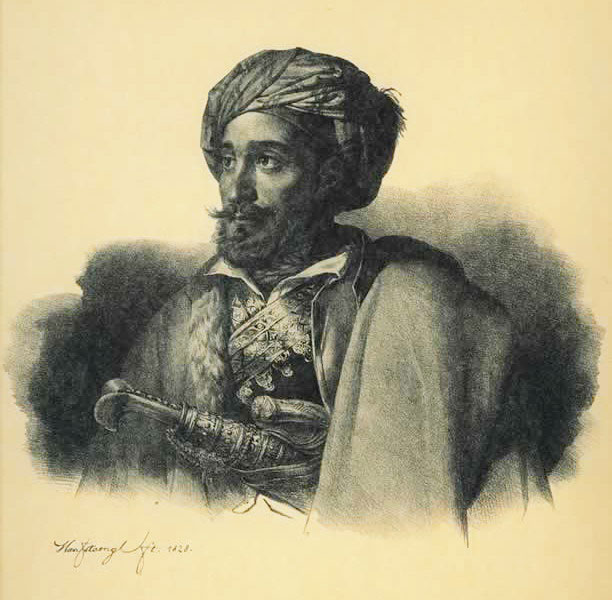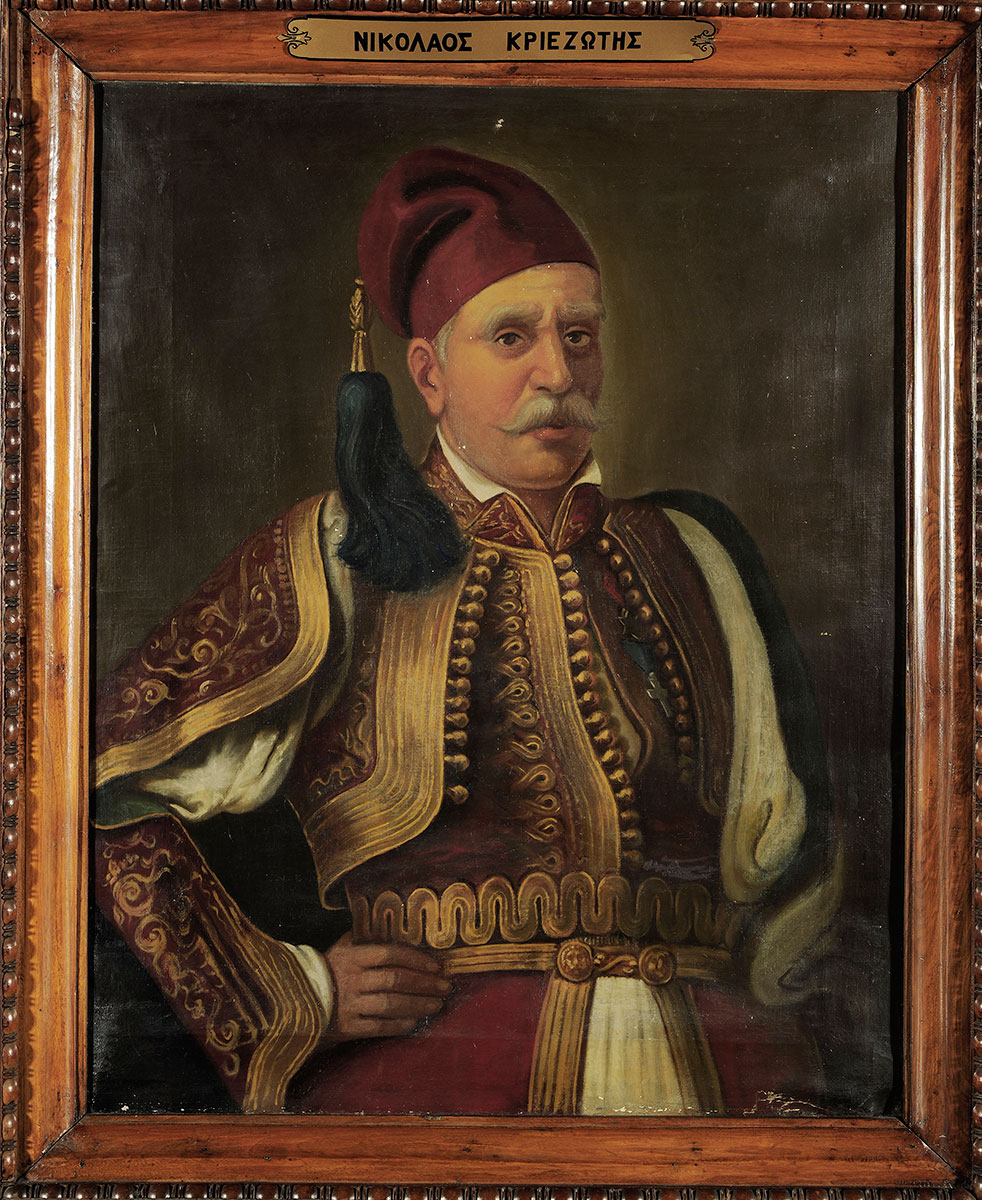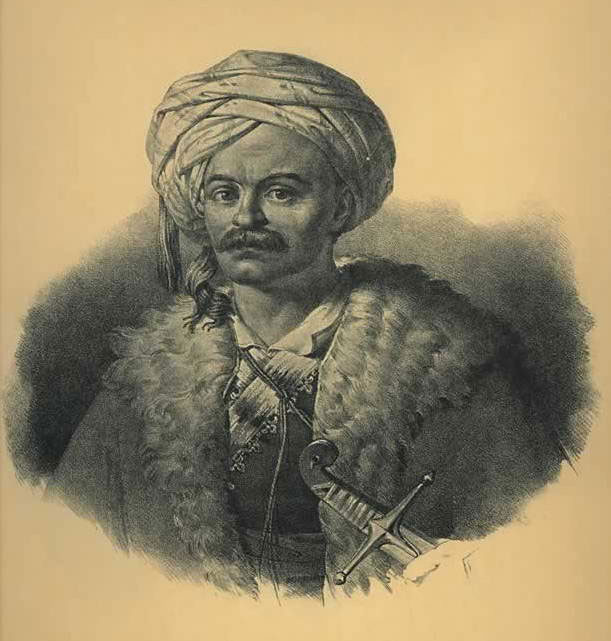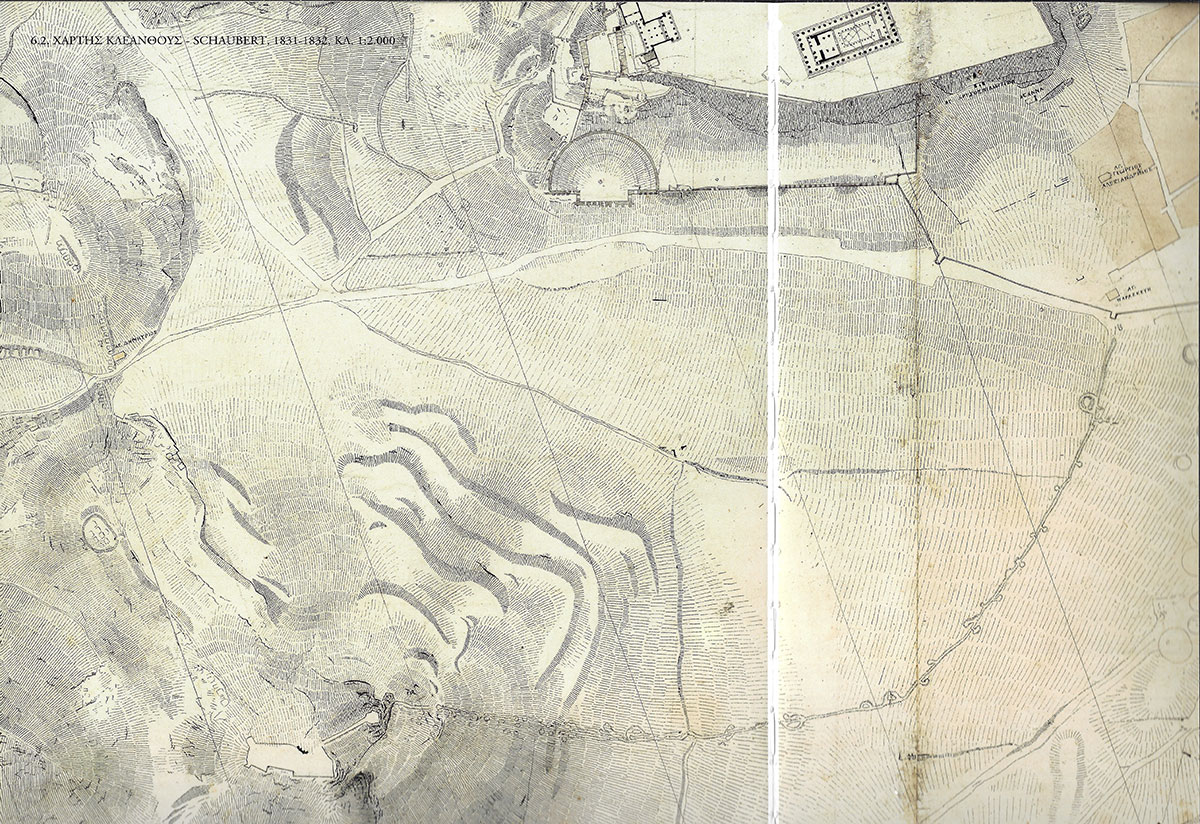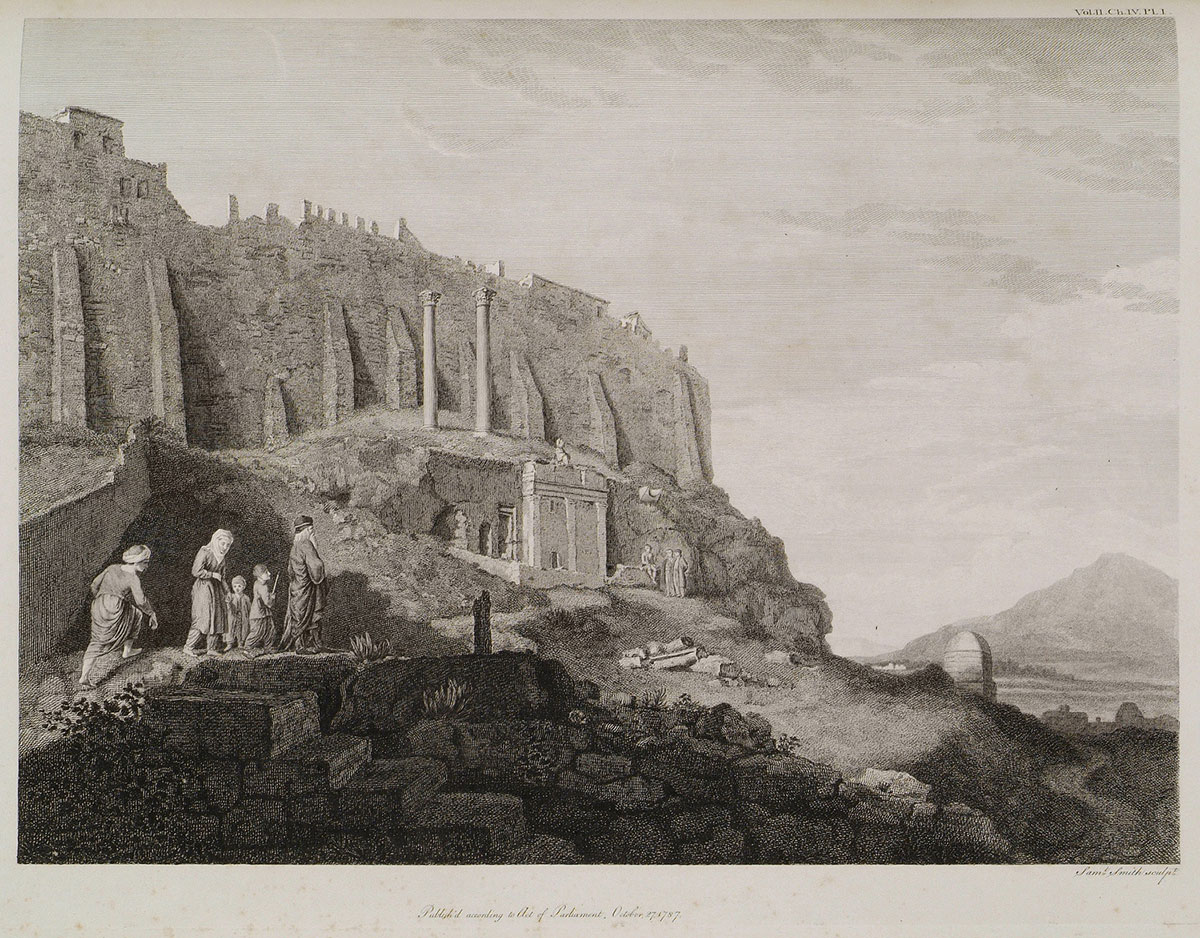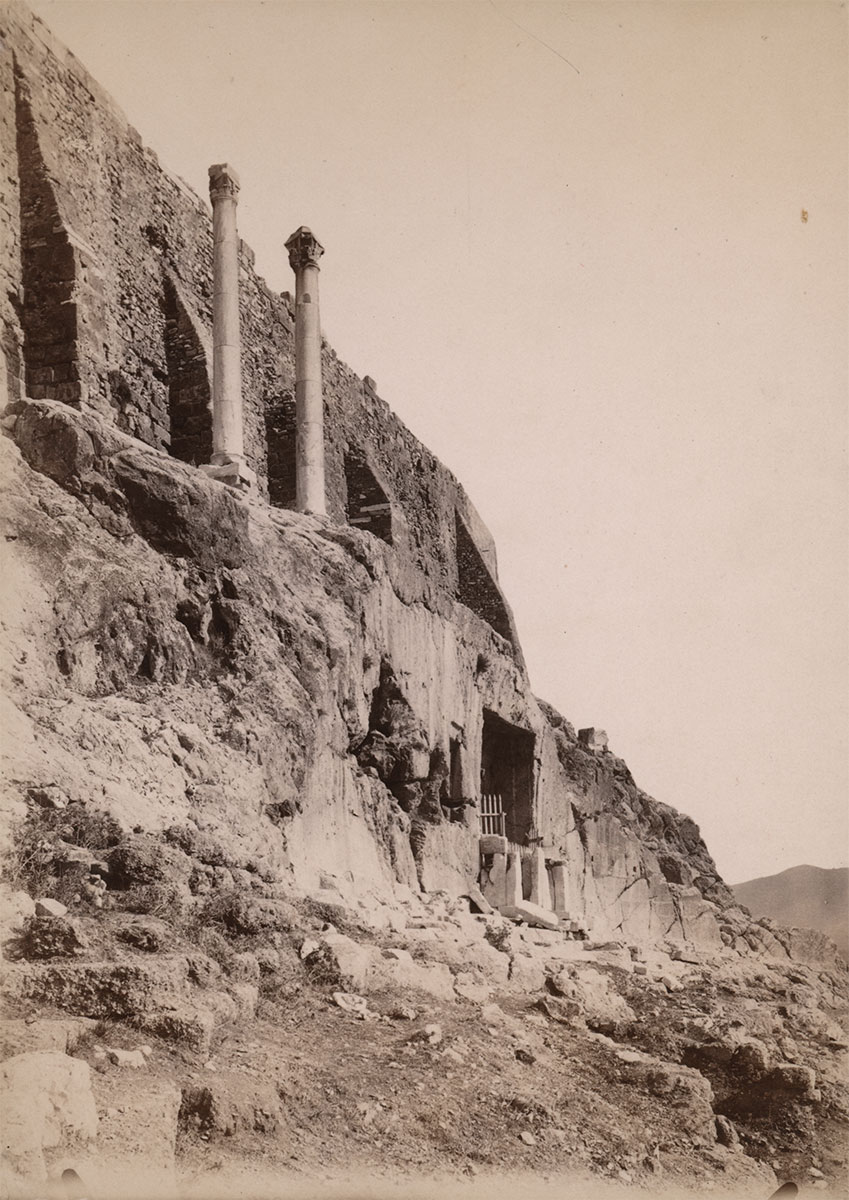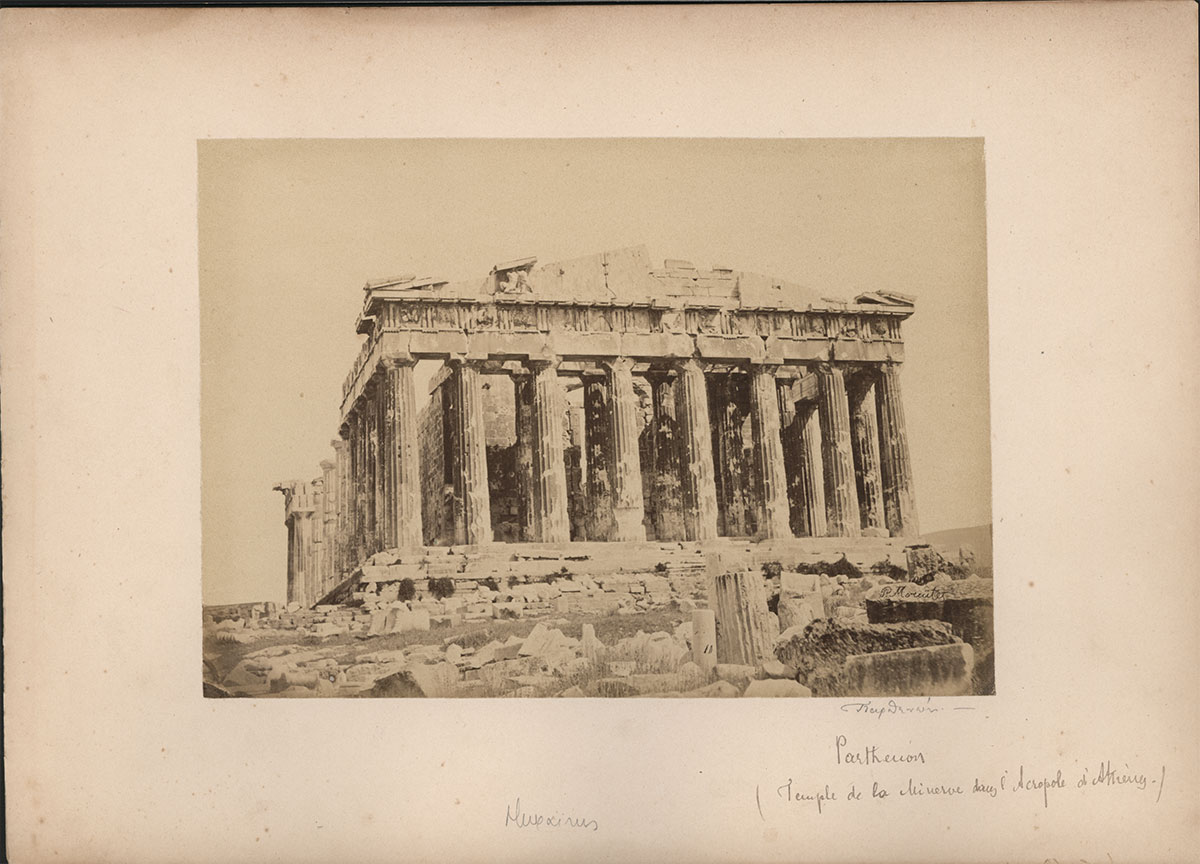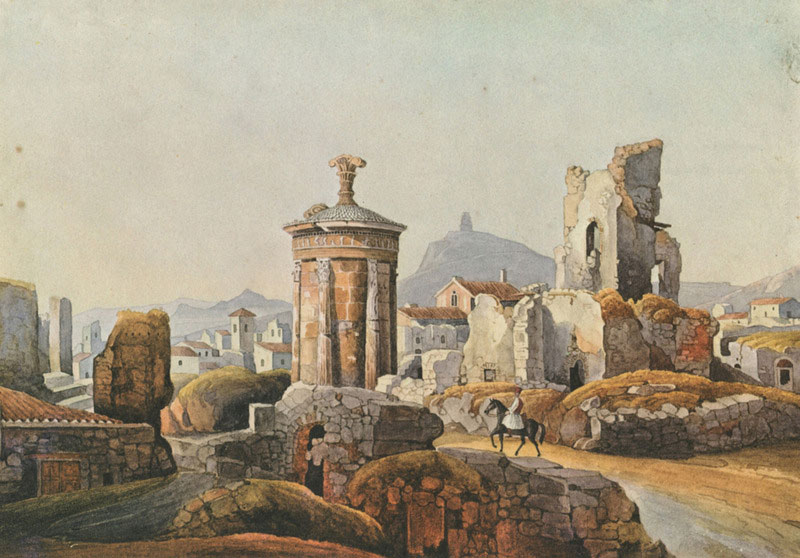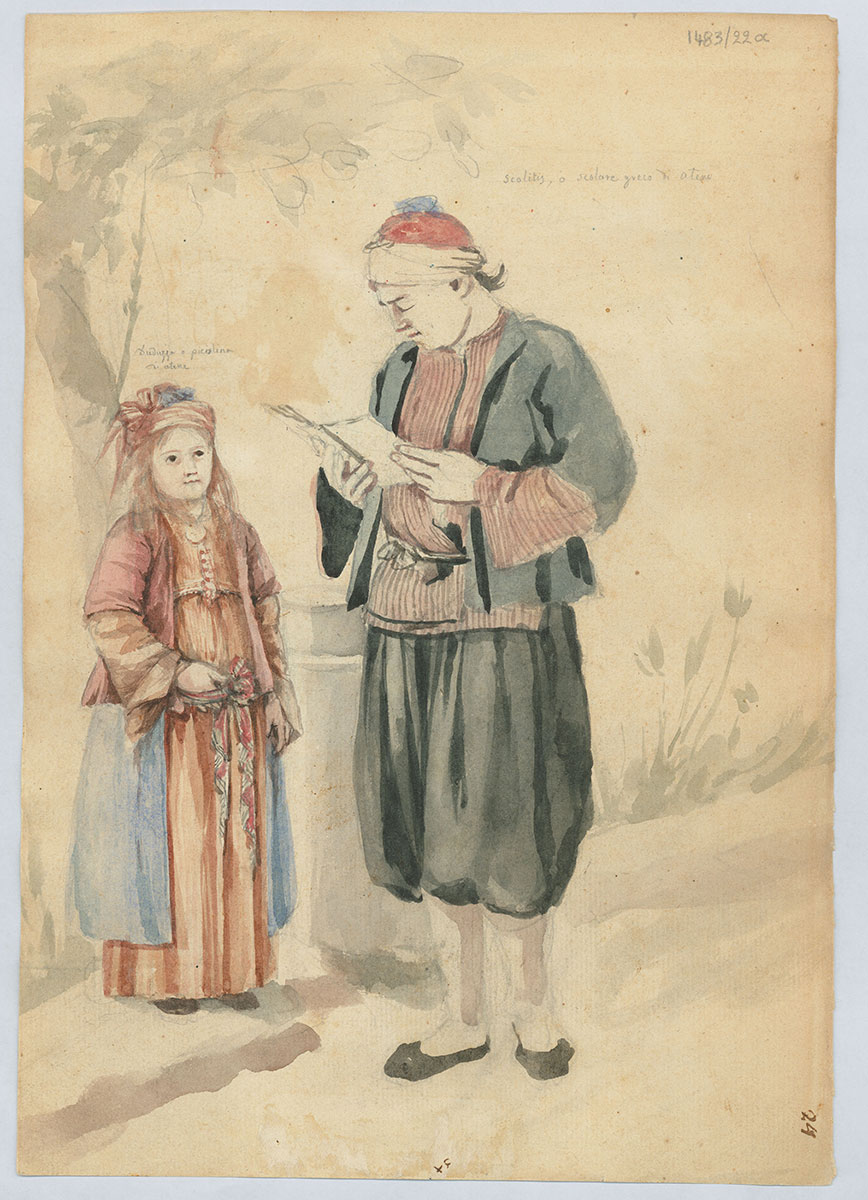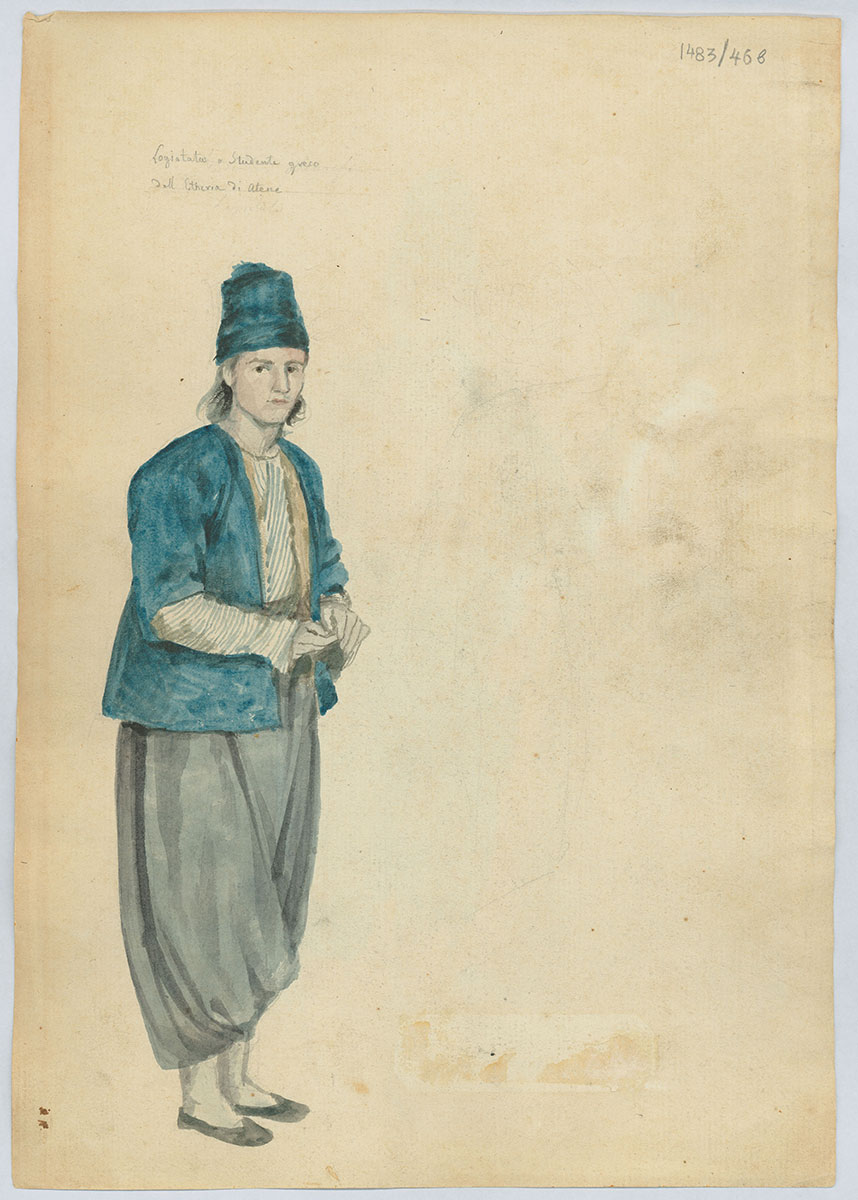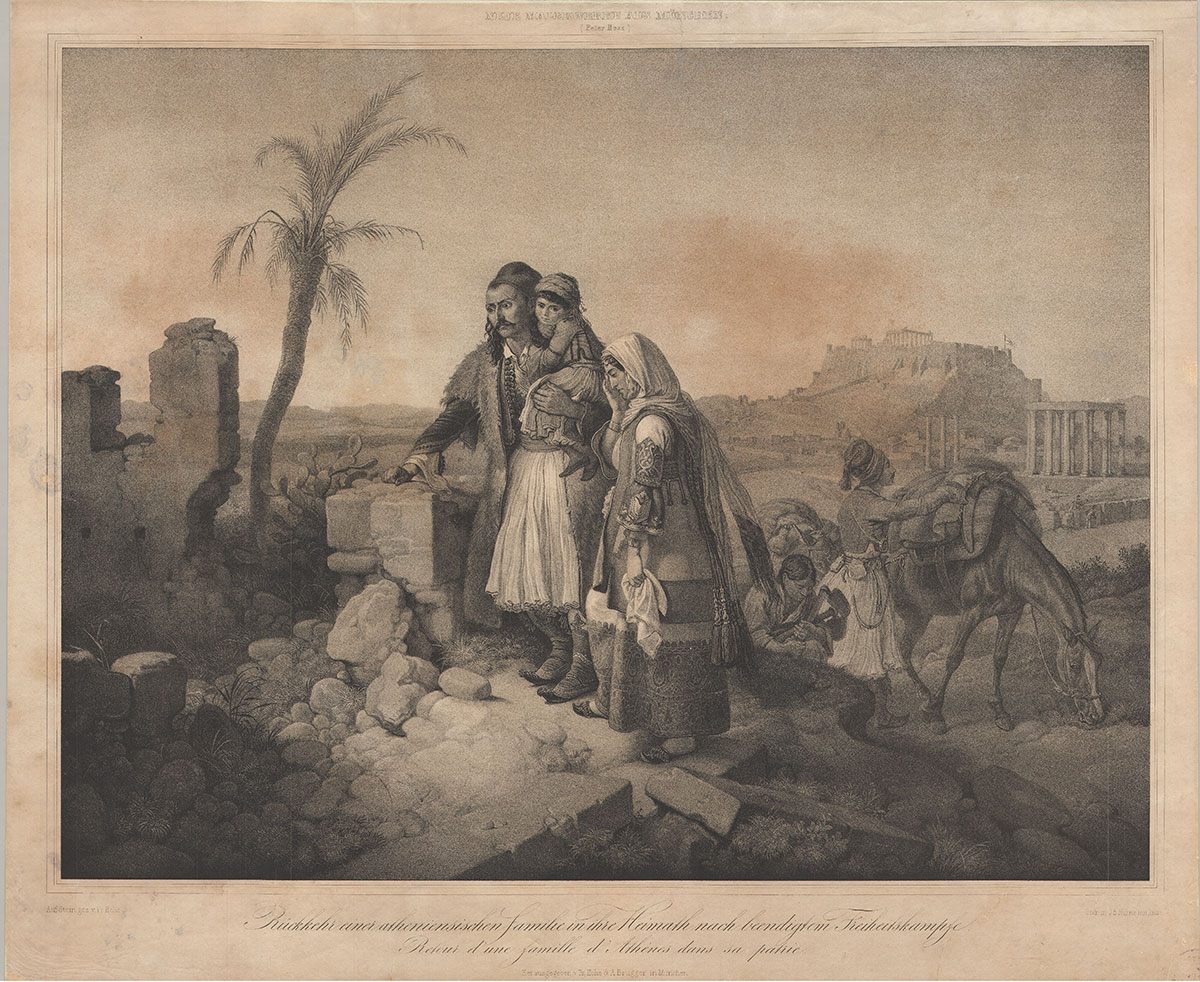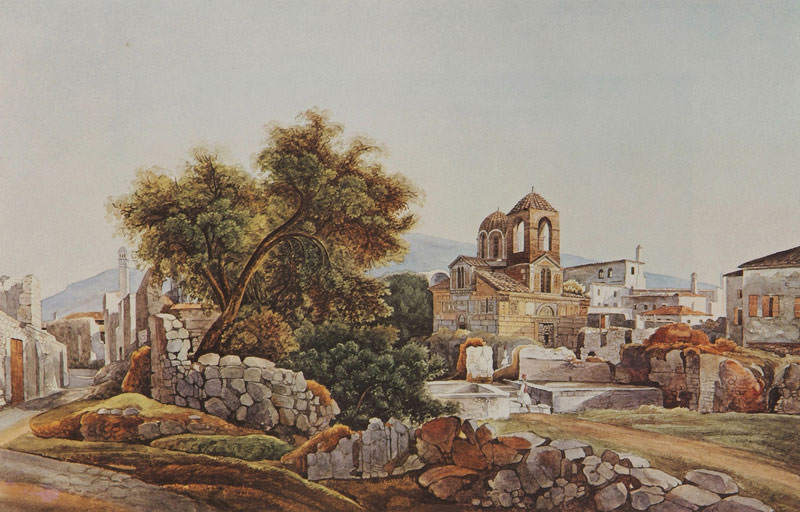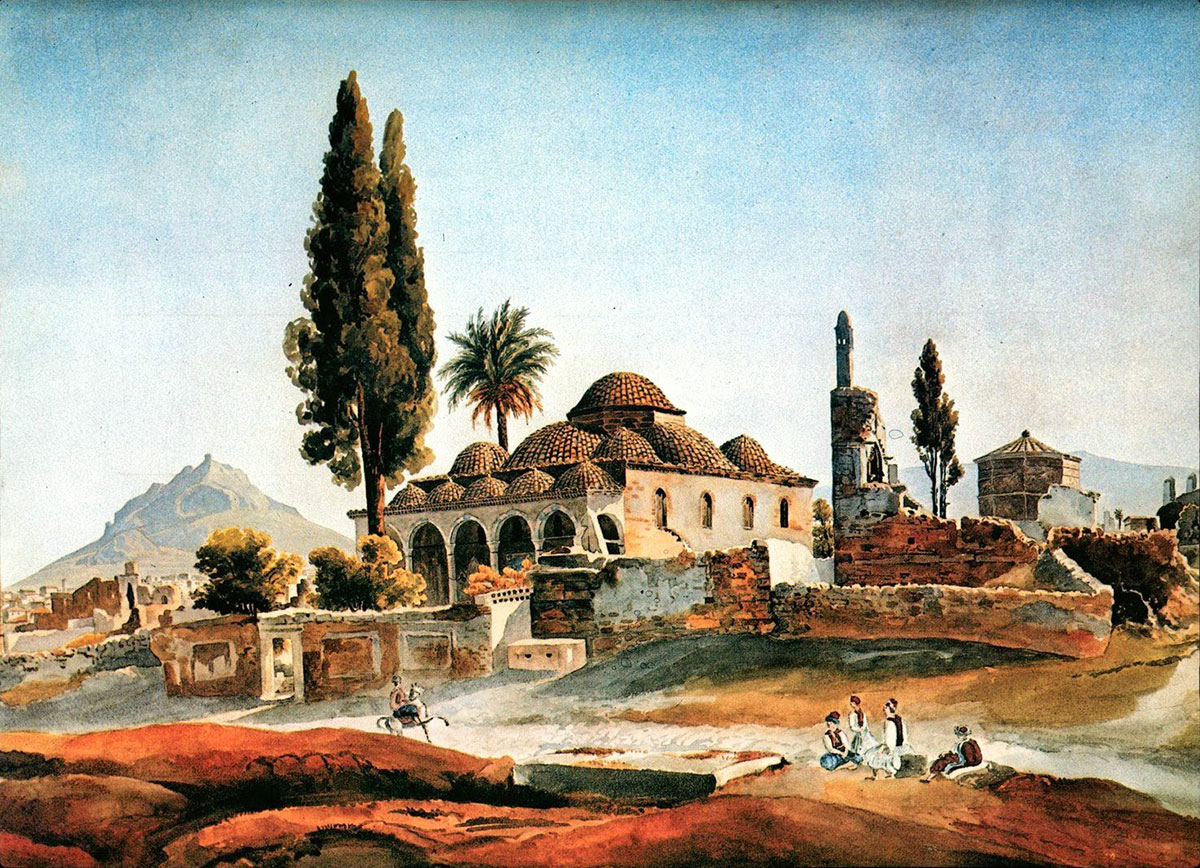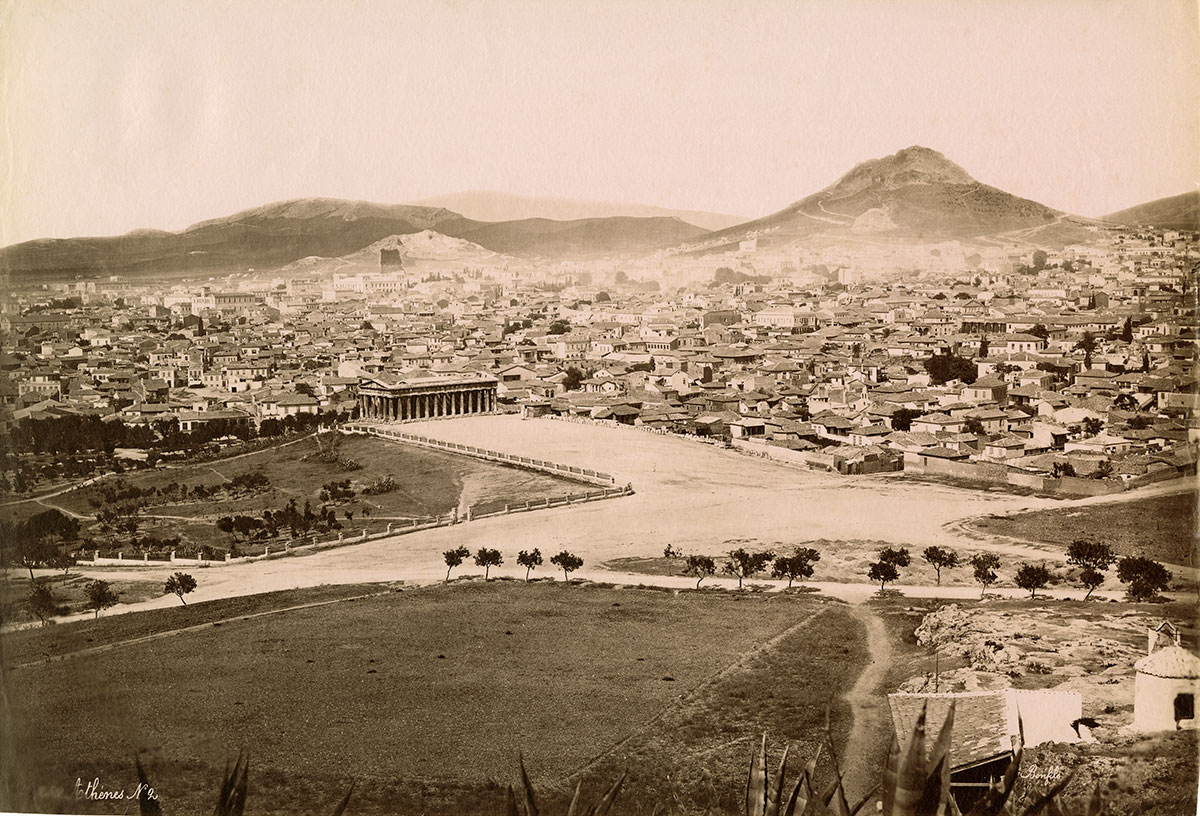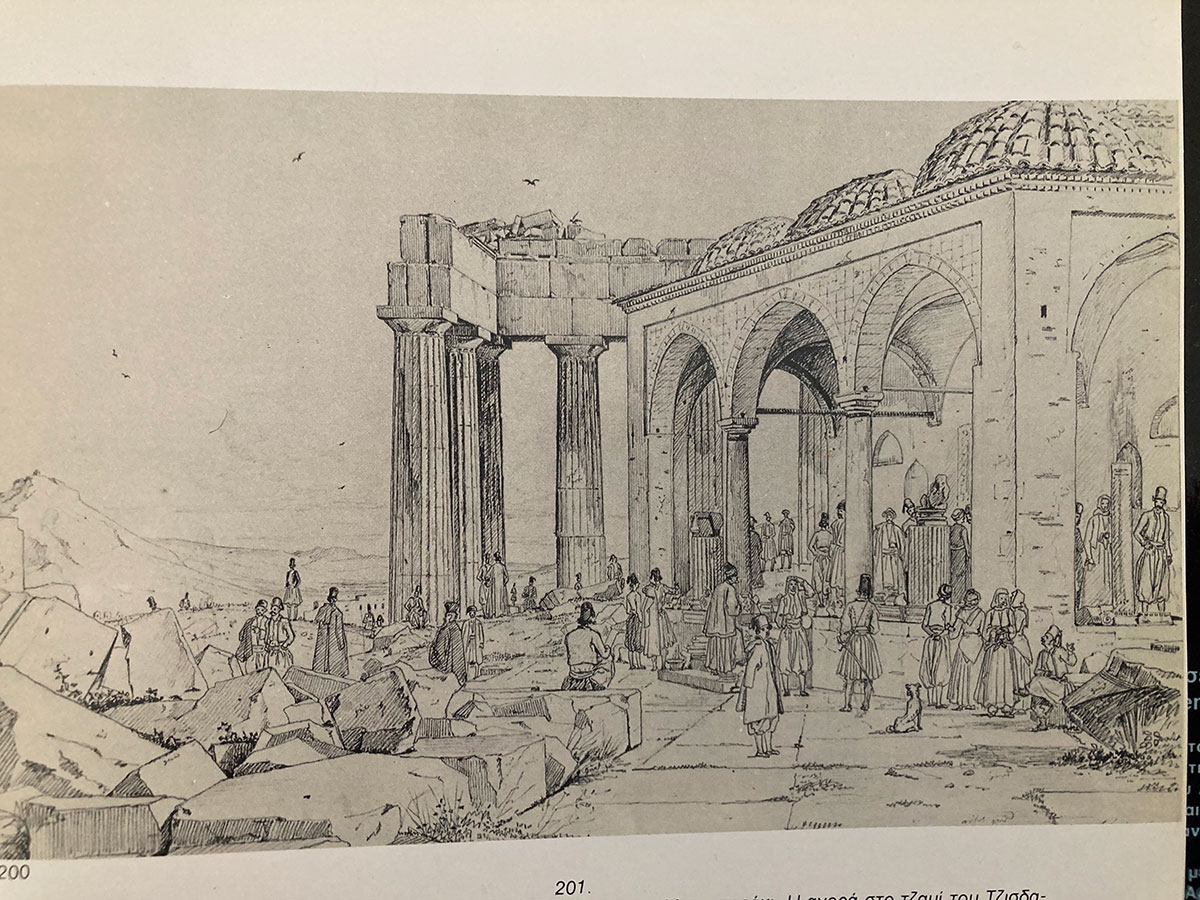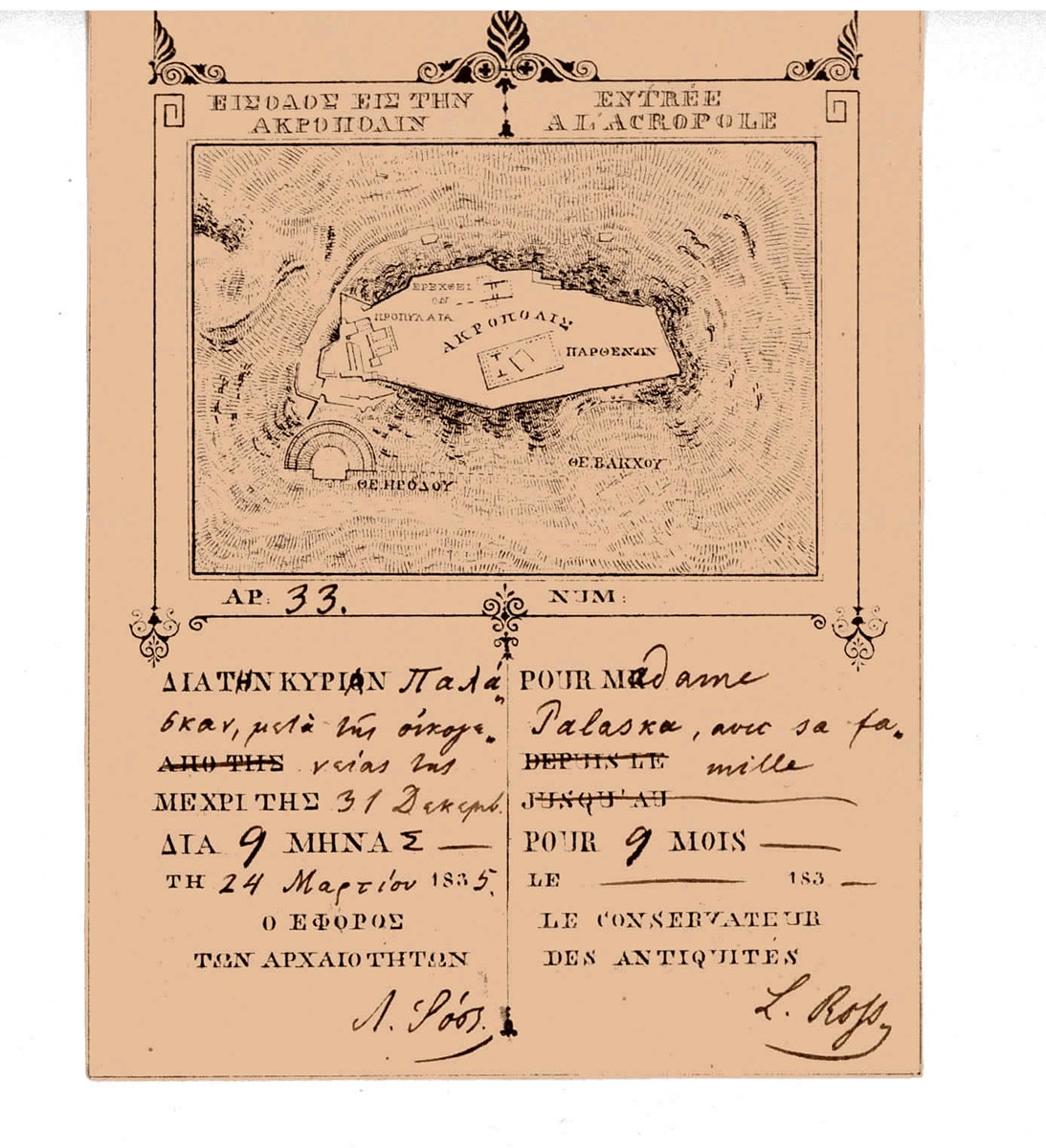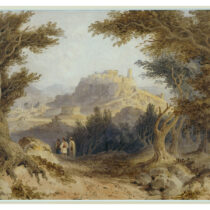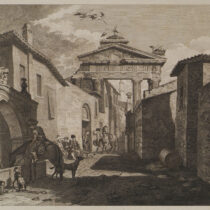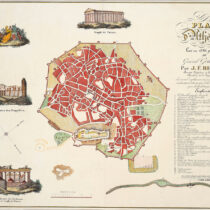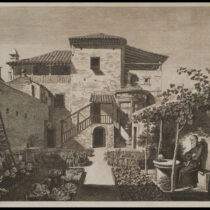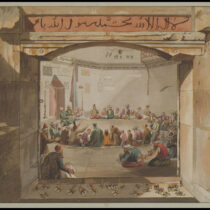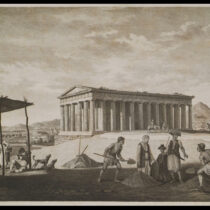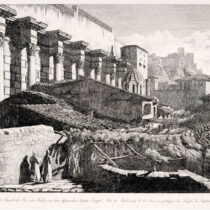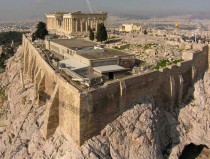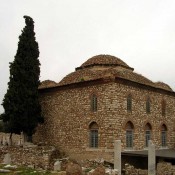The vicissitudes of Athens and the Acropolis during the 1821 Revolution are a representative summary of every aspect of the Greek War of Independence: the intellectual preparation for the national uprising via education and the turn towards Classical antiquity, patriotic enthusiasm, the courage, the exploits and the endurance of the rebel fighters, their passionate embroilment in civil conflicts, and the decisive involvement of foreign powers and their contribution to the outcome of events, in this case the preservation of the city’s antiquities and the lives of its inhabitants. Let us take a closer look at the situation (note 1).
Athens on the eve of the Revolution
Athens on the eve of the Revolution was a small provincial town of the Ottoman Empire. In the eyes of the enlightened world, however, especially Europe but also America, it was the Source of Art (The Antiquities of Athens, I, p.v) and the cradle of the ideals of liberty, democracy, equality and justice. European visitors, whose numbers had begun to increase at the turn of the 19th century, saw an idyllic picture: a town, the chora as it was called, spread out across the northern and eastern foot of the imposing castle of the Acropolis, set in a magnificent landscape with a crystal-clear atmosphere under a brilliant sun. West of the Acropolis they gazed out at the bare hills of the Muses, the Pnyx and the Nymphs, with unimpeded views stretching as far as Piraeus and Phaleron. The hills were dotted with rock-studded traces of roads, walls and houses, and also built-up remains, indicating the size and form of the ancient city. Among them stood out the Seggio Hill, as the Philopappos Monument was known. To the south they viewed Hadrian’s Arch, incorporated into the later circuit wall around the town, and the ruins of the Olympion, while behind it, in the background, they could make out the traces of the ancient stadium on the hill of Ardettus, with the River Ilissus and the remains of an ancient bridge in front of it. Further east, in the area where the royal gardens would be laid out after foundation of the Greek state, they could see the scattered ruins of Hadrian’s expansion of the city, and higher up, on the lower slopes of Lycabettus, the remains of the cistern of the aqueduct of the same name. Turning their eyes northwards, they gazed upon open countryside, cultivated fields, farmhouses with towers, small churches, many fountains, and a dense, luxuriant olive grove reminiscent of the famous Grove of Plato’s Academy (fig. 1).
The town was surrounded by a low, roughly made wall which had been built recently, in 1778, on the orders of the Voivode (governor) of Athens Hadji Ali Haseki, using local forced labour and stone robbed from ancient monuments, which had almost disappeared as a result. Most of the wall was founded on the traces and remains of the Classical wall of ancient Athens. The Wall of Haseki had tower-like projections called bourjia and gates pierced by ancient roads leading to the Peloponnese, Boeotia, the hinterland and coasts of Attica, Phaleron and Piraeus (fig. 2). Within the circuit, between the wall and the first houses of the town, was an unbuilt zone with a few churches, fountains and cultivated fields (Τραυλού 1993, 195-200).
The town of Athens itself was just as picturesque and idyllic: low one- or two-storey houses, with roofed balconies, walled courtyards and fragrant gardens, were intermingled with a host of medieval churches, many fountains, and secular and religious Ottoman buildings, forming an enchanting mosaic. However, the most striking features of the town were the ruins of its glorious ancient predecessor. These were everywhere, either as individual members and broken fragments strewn around the streets and courtyards or incorporated into contemporary buildings, or as standing ruins of varying heights and states of preservation.
Some of these were preserved almost intact within later buildings. A relatively representative example was the Choragic Monument of Lysicrates, which had been incorporated into a French Capuchin monastery since the 17th century (Παγώνη 1993) (fig. 3). Others were self-standing, having acquired a new use, like the Horologion of Andronikos of Kyrrhos –better known as the Tower of the Winds – and the Temple of Hephaestus and Athena – the famous Theseion: the former had been turned into a dervish tekke (fig. 4), while the latter served throughout the Ottoman period as a church dedicated to St George Akamates (fig. 5). Other ancient buildings and complexes, preserved in ruinous condition but to a great height, adjoined key parts of the city, bustling with life, or had been modified to serve contemporary needs: the most important part of Athens, the Pazari (bazaar or market), the administrative/political, economic, religious and social centre of the town, occupied the interior of the ruins of the ancient complexes of Hadrian’s Library and the Roman Agora or Forum, their immediate environs and the surrounding streets. Here stood the most important buildings of the town: the konak of the Voivode, the residency of the high Ottoman official (Κνιθάκης, Μαλλούχου, Τιγγινάγκα 1986) (fig. 6); the kousegio, the seat of the Christian Demogerontia (Council of Elders); the kadiliki, the seat of the kadi (magistrate); the customs house, mosques, a madrasa (religious school), dervish tekkes (meeting houses), churches, a school, an inn, coffeeshops and hammams (fig. 7). The two main streets of the town crossed here. The first, the tsarsi, where the weekly market was held (fig. 8), ran north to south, leading up to the Acropolis. The second, running west to east, reached the bazaar through the Gate of Athena Archegetis of the Roman Agora, then known as the Pazaroporta (Market Gate) (fig. 9). In the open space at the crossroads of the two streets, the Staropazaro (Wheat Market), the annual market was held. The daily market mainly extended around Hadrian’s Library, along the surviving sections of its north and east enclosure, and the north wing of the west front. Another imposing ruin, the Stoa of Attalos, then thought to be the Gymnasium of Ptolemy, rose on the west side of the Agora, incorporated into the remains of the Late Roman city wall and re-adapted to house homes and workshops (fig. 10). Finally, workshops and craft shops continued to the northwest, in the exopazaro (outer bazaar), in the area of Agios Philippos and today’s Abyssinias Square, Kerameikos and even further afield, in the exechoro, the area of the town outside the walls (Τραυλού 1993, 218-222, Καρύδης 2015, 172-181).
Athens at the time of the Greek War of Independence numbered, according to the official census of October 1824 carried out by the Police Commander General Moschos Athanasiades, 1,605 houses and 9,040 inhabitants, including those living outside the walls. The inhabitants, most of whom were Christians, comprised Greeks (fig. 11), Turks (figs 12, 13), Arvanites (fig. 14), “Egyptians” (Gypsies) and a few Ethiopians. The town was divided into administrative units called platomata, which included the parishes or neighbourhoods. Despite their ethnic differences, the inhabitants of Athens coexisted harmoniously. The houses of the Ottomans, the wealthier Greeks of higher social rank and the representatives of foreign countries were located around the bazaar (fig. 15). The neighbourhoods directly under the north slope of the Acropolis were inhabited by Greeks. Arvanites had settled northeast of the Rock, in the Plaka area, since the 16th century (Καρύδης 2015, 81).The Gypsy blacksmiths and coppersmiths lived in the industrial zone, on the northwest edge of the town. The exechoro was also becoming more densely inhabited during this period (Μπίρη 2017, 97-99).
Athens was dotted with small and medium-sized churches; there are estimated to have been 130 within and outside the walls. It also had around 40 fountains, a rudimentary aqueduct known as the kondito, and three public hammams. The religious needs of the Muslim inhabitants were met by mosques (four large and several smaller ones), some prayer houses, Dervish tekkes and a madrasa (Παπαγεωργίου-Βενετάς 2010, 16).The town’s main source of wealth was agriculture, especially olive oil production, although it also produced wheat, honey, wax and silk. Animal husbandry flourished during the period of the Revolution, with dairy products, wool and hides. Athens also had small industries engaging insilk-making, tanning and leatherworking,as well as soapmaking (using olive oil and caustic potash), while exports of agricultural produce – mainly olive oil but also honey and wax – to Western European and Black Sea ports are recorded (Καρύδης 2015,102-109).
The Acropolis, the impregnable castle
As ever, the town was dominated by the Rock of the Acropolis, with the fortress at its top (fig. 16). The Acropolis had been transformed into a stronghold over a long period of time, beginning in the late 3rd c. AD, when, after the destruction caused by the barbarian raid of 267 AD, the western access and part of the south slope of the hill were fortified. The fortifications grew over the following centuries, particularly after 1204 and the period of Latin rule of Athens and Greece. During the time of the Revolution, the ancient and medieval fortifications, the Late Roman wall and the Rizokastro, a wall enclosing the foot of the hill of the Acropolis and dating to the early 13th century, had been concealed under later structures or lay buried in the thick fill covering the surface of the ground. The hill was now protected by new walls, the Serpentzes Wall on the south and the HypapanteWallon the northwest. The Serpentzes, constructed by the Ottomans in the late 17th century on the ruins of the Late Roman wall on the south slope of the Acropolis, defended the areas of the ancient Temple of Asclepius and the Odeon of Herodes Atticus (fig. 17). The mid-18th-century Hypapante wall defended the west side of the Acropolis up to the Lion Gate and Tower, roughly in the middle of the north slope (fig. 18). The Lion Gate, which was protected by a strong tower (fig. 19), was the main entrance to the Acropolis from the town, at the end of the north-south street from the bazaar. Both these outworks joined the Wall of Haseki surrounding the town. The weakest side of the hill of the Acropolis was the west, which was also fortified with a strong gate with towers in the 3rd century AD and continually reinforced during the medieval period. At the time of the Revolution it had become an extremely strong system of defences, with an inner wall with a tower and three concentric rows of bastions with cannon embrasures (fig. 20). Through them ran the only access route to the inner fortress. Narrow and winding, controlled by successive gates, it ended inside the fortress, passing through a final gate south of the medieval tower – the koules, as it was called during the Turkish period – which had occupied the south wing of the Propylaea since the 14th century (Tanoulas 1987).
Τhe inner plateau of the fortress was covered with the homes of the soldiers defending it. It was literally a whole village, with streets, houses with gardens and rainwater tanks, three large cisterns, a small hammam and ammunition stores. Among them rose the glorious ruins of the Classical monuments (fig.21). In the Parthenon denuded by Elgin’s agents, a small mosque served the religious needs of the fortress’s inhabitants. On the ground all around were still strewn many marble remains of the explosion of 1687. The Erechtheion was also in ruins; only the north portico was still functional, part of it having been turned into a powder magazine and the upper part into a residence (fig. 22). As for the Propylaea, the ends of the columns of the inner east portico were only just visible above the thick fill (fig. 21).
The final major reinforcement of the castle was carried out by the Greek rebels when they captured it after a siege of several months in June 1822. The forgotten ancient spring of the Klepsydra was rediscovered in the northwest corner of the hill (figs 23, 24). Enclosed by a strong bastion – the Water or Dysseas Bastion, named after the rebel leader Odysseas Andritzos, who ordered and paid for its fortification – it was united with the rest of the castle and began to be reused (fig. 25) (Burnouf 1877, 39-41). The plentiful water supply, combined with the steep terrain and the available defences, now rendered the Acropolis practically impregnable. This was conclusively demonstrated a few years later, when Reshid Mehmed Pasha of Rumeli, to whom the Greeks gave the mocking sobriquet of Kütahi (because he had been governor of Kütahya), attempted to recapture it. He eloquently described the situation in a report to the Sublime Porte (the Ottoman central government): The Fortress of Athens, as you know, has been built since olden times on a high and inaccessible rock, and can neither be undermined nor taken by storm... Kütahi also adds: and, above all, this Fortress, because the place is most ancient, and in olden times many renowned philosophers originated from this land, and the engineering works of antiquity cause the admiration of educated Europeans; for this reason all the Europeans and the other nations of the infidels view this Fortress as their own private residence; and because they consider it a shrine, both the Europeans and the other nations of the infidels, those called Christian, defend it; and they attempt to prevent it from leaving in the hands of the unbelieving apostates… (Σουρμελής 1853, 159-160). Kütahi, perhaps more than any other Ottoman official, understood the intimate connection between the ancient Greek antiquities and the birth of a national consciousness in the enslaved Greeks, and of course their crucial contribution to the creation of a philhellene sentiment in Europe, which was to play such a decisive role in the course and the ultimate outcome of the Greek War of Independence.
Athens, the Source of Art
Indeed, it was the circulation in Europe, during the second half of the 18th century, of the first systematic plans based on precise measurements and the first scientific treatises on the art and architecture of the antiquities of Athens and the Acropolis (figs 26, 27), that drew the city out of obscurity, making it the focus of interest of European artists and intellectuals. Thus, in the first two decades of the 19th century Athens was flooded with European visitors, antiquarians but also antiques looters, who roamed the town, getting to know both its ancient monuments and its inhabitants (Mallouchou-Tufano 1994, 175-185). Foreign visitors were welcomed, hosted and assisted by the consuls of their respective countries, the Capuchin monks, and also by Louis-François-Sebastien Fauvel and Giovanni Battista Lusieri, both long-time residents of Athens. Fauvel, a famous figure of the city at the time, promoted both the study of and the trade in antiquities. Lusieri, Lord Elgin’s agent in the ravaging of the monuments of the Acropolis, now abandoned by his patron, survived by offering his services as a guide. The foreign visitors also met Athenians educated at the schools of the monk Grigoris Sotiris and the Venetian of Greek origin Ioannis Dekas, which had been established in the centre of Athens since the early and mid-18th century respectively, and the members of the Philomuse Society, active in the town since 1813.
Founded by Athenian city elders, the Philomuse Society aimed high from the very start, declaring its goals to be: cultivating and enlightening the Greek spirit of the young through the study of the sciences, the publication of useful books, the provision of aid for indigent students, the discovery of antiquities, the collection of Inscriptions on stone, Statues and Utensils, and anything else worthy of attention. The archaeological items collected shall be stored in a place appointed for the purpose, called a Museum, so that they may be viewed by those who love such things. The aims of the Society also included providing foreign visitors with tours of Athenian monuments, monitoring and halting theirillicit procurement of antiquities, and looking after the monuments. Ambitious plans to expand the Society throughout Europe, beginning with the establishment of a branch in Vienna in 1814, were soon interrupted by the policy of the restoration of the European monarchies set out by the Congress of Vienna. In Athens, however, the Society’s activities continued unimpeded: it ensured the operation of the Athenian schools, particularly the famous School of Dekas, which had fallen into dire financial straits when the founder’s bequest evaporated at the Fall of the Venetian Republic in 1797; it also worked towards the establishment of a Library, which would also serve as a museum for the collection of antiquities, and provide scholarships to send young men to seek a higher education in Europe. One of those young men was Georgios Psyllas, the future editor of the Ephemeris of Athens, the first newspaper published in the city during the War of Independence; another was the noted Κyriakos Pittakis, the first Greek Ephor (Superintendent) of Antiquities of the newly established Kingdom of Greece (Κόκκου 1977, 32-34). Finally, the Society undertook the first “curation” of a monument, consolidating with aniron ringa segment of the northwest column of the “Theseion” which was cracked across by a lightning strike in May 1821. All these activities were abruptly – but temporarily – interrupted by the outbreak of the revolt.
In the turmoil of war
As ones long prepared, the villagers of Attica and the Athenians immediately joined the other Greek revolutionaries (fig. 28). From all around there echoed patriotism, zeal, the rivalry of good with the general cry, “a free life or a glorious death”. The Greeks had reached such a degree of enthusiasm at that time thatthe passion can only be compared to an epidemic mania for death in the cause of liberty, diffused throughout the whole of Greece; for you saw all, young and old, raging for death for the Homeland, writes the historian of Athens Dionysios Sourmelis, a witness to and active participant in the events of the Revolution (Σουρμελής 1853, 13). The events that followed over the next six years are too well known to be narrated here in detail, so I will simply remind readers of the key points.
In April 1821, the rebel villagers of Attica stormed Athens, took the town and plundered the homes of the Turks, who sought refuge in the fortress of the Acropolis. In July the military commander of Karystos Omer Vrioni arrived in Athens, coming to the aid of the besieged Turks at the head of an army of Arnauts (Albanians). He captured the town, also causing widespread damage. The Athenians fled to Salamis and Aegina. Omer Vrionide parted from Athens in October, leaving a small garrison behind to protect the Turks. The Greeks immediately rose up again, resoundingly defeated the Turks at Chalandri, re-entered Athens and laid siege to the castle of the Acropolis on 3 November 1821 (fig. 29). The siege lasted seven months, to 10 June 1822, when the Ottomans, exhausted by hunger and thirst, capitulated. There followed four years of freedom for Athens, under the rule of the Demogerontia (Council of Elders) and the protection of the commanders of the castle garrison, first Odysseas Andritzos (1822-24) and then Ioannis Gouras, and their corps of irregulars.
During this time, from April to August 1824, there was a serious but unsuccessful Ottoman attempt to retake the town, with Omer Pasha of Euripos leading an expedition to Attica. On the Greek side, the Athenians suffered the impact of the Second Civil War, in which Andritzos and Gouras both participated; the war ended with the violent execution of the former in the Castle of the Acropolis in June 1825. After the fall of Missolonghi in April 1826, Kütahi marched on Attica and Athens: in June he captured the villages of Attica, on 3 July he camped outside the wall of Athens and besieged it, and on 2 August he entered the town. There followed a progressively harsher ten-month siege of the castle of the Acropolis (fig. 30) until 24 May 1827, when the besieged fighters – Greeks from Athens, Central Greece and the Ionian Islands, together with many foreign Philhellenes – succumbed to hunger, thirst and lack of ammunition and surrendered with the intervention of representative of the Protective Powers.
The vicissitudes of Athens and the Acropolis during the Revolution of 1821, and particularly in the years 1826-27, are a tale of courage and self-sacrifice, individual and collective deeds of heroism, and, above all, endurance. During the second siege, the Acropolis was surrounded by a ring of fire that grew ever tighter, hammered day and night by cannon firefrom the surrounding positions: the Pnyx, the Hill of the Muses (Philopappou), the Columns (Temple of Olympian Zeus), Ardettus Hill, the Theseion and the Hill of the Nymphs (Agia Marina). At the same time, both sides launched attacks and counterattacks using mines (tunnels filled with gunpowder and exploded) and countermines, usually targeting two areas, the Serpentzes Wall, thought to be the weakest point of the fortress, and the Lion Gate, next to the Water Bastion. These episodes gave the fighters the opportunity to display their personal bravery. All contemporary writers praise the courage, the fighting spirit, the patriotism and above all the mine-digging skill of Kostas Hormovitis or Argyrokastritis, nicknamed Lagoumtzis (“tunneller”) (fig. 31), the brave deeds of Makrigiannis (fig. 32) on the Serpentzes Wall on 7 October1826, and the valour and self-sacrifice of Nikolaos Kriezotis and Charles Nicolas Fabvier (figs 33, 34), who, at the head of regular and irregular corps respectively, broke through the ranks of the besiegers on 11 October and 30 November 1826 (fig. 35) to deliver ammunition and medicine to the castle (Diary of Ν. Karoris).
From January 1827, the siege of the castle of the Acropolis became an endurance test. As recently published Ottoman sources show (SükrüIhcak 2019, 254-257), besiegers and besieged faced exactly the same problems: lack of money, lack of ammunition, lack of food, and a tendency for the Arnaut mercenaries employed on both sides to desert due to lack of payment and the length of the siege. Both sides were aware of the importance of the Acropolis as the last rebel castle. Finally, both sides were aware of foreign intervention in the Greek Revolution, which they saw from their respective points of view: the Ottomans were in a hurry to close the case, while the Greeks wanted to keep it open until the solution in the making came to pass. The Ottomans won the Acropolis, but it was a Pyrrhic victory: on 6 July 1827, just six weeks after the castle’s surrender, the Treaty of London was signed, imposing an armistice between the combatants and opening the way for the creation of an independent Greek state.
However, two parameters affecting the fortunes of Athens and the Acropolis during the Greek Revolution are worth mentioning here: the concernsabout the fate of the monuments of the Acropolis and the exhortations for their safeguarding during the war, which were expressed by all sides at every level, and the significant cultural activity that arose in the city during the years of its free government (1822-26).
Concerns regarding the fate of the monuments of the Acropolis were expressed from the very outset of the Revolution by the most official voices. Following the intervention of the British ambassador to the Sublime Porte, the Sultan issued a decree on 22 August 1822, commanding both Köse Mehmed Pasha of the Morias and Omer Vrioni to respect the monuments during their attacks to suppress the revolt in Athens (Sükrü Ihcak 2019, 245-246). According to the French Philhellene Olivier Voutier, the artillery commander during the first siege of the Acropolis, the Greek Provisional Administration sent him mortars from Corinth, accompanied by the following message: The submission of Athens ensures your glory… But do not forget that in the fortress are shut those precious remains of antiquity, remains that destroying time has been unable to annihilate. We recommend to your love of beauty the masterpieces of our ancestors. May the aegis of Minerva protect her temple! Voutier himself was similarly reluctant, as he admits, to use these extreme means. I felt my heart constrict at the thought of the ills that were to afflict the unarmed section of a people against whom I could not have the same animosity as the Greeks. I was also afraid of ruining the ancient monuments; but my repugnance was defeated: “Do not we, too, have wives, children, fathers?” the Athenians said to me; “They languish in exile and misery, while death menaces them on all sides!… As for the monuments of our ancestors, if it is necessary, let us sacrifice these remains to obtain liberty, which will restore to us our Metagenes and Callicrates.” I saw, besides, the Turks pulling down the marbles of the cella of the Parthenon every day, to take the lead that bound them and make bullets from it (Voutier 2019, 136). So the mortar battery was set up on the Pnyx.
The pressure mounted yet further during the second siege of the Acropolis, when it became known that Kütahi wished to destroy the monuments of the castle, which recalled the ancient glories of the Greeks and played a decisive part in their uprising. The British ambassador was the first to send a diplomatic letter to the Pasha himself, in June 1826, enclosing a copy of the Sultan’s decree of 1822. His French counterpart followed suit in August. The Pasha of Rumeli reassured them both, assuring them that he had ordered that the monuments should not be destroyed, for the sake of the friendship he bore them (Sükrü Ihcak 2019, 253-254). Later, as the siege wore on, pressures were exerted on the Greeks, both by the representatives of the Great Powers and by foreign Philhellenes who had thrown themselves into the struggle. Fabvier (fig. 30), who was trapped in the castle himself, made constant attempts to persuade his fellow-fighters to capitulate. They, not wishing to seem less brave than the defenders of Missolonghi, had decided to destroy the whole castle in an act of suicide, and had even begun to dig tunnels under the fortress: …even though the precious works of antiquity should be lost with them. …those, although lifeless, yet cry out and curse us, should we abandon them hereafter to the discretion of the barbarous enemy (Σουρμελής 1853, 231). On 30 April 1827 the commander of the Greek forces, Sir Richard Church, ordered the defenders to surrender, stressing the need to preserve the ancient monuments of the Acropolis. As Sourmelis bitterly notes, but other means beyond our willingness and intent achieve the surrender of the fortress, and we, our aims frustrated, lose the glory, so that the antiquities should not be lost. The capitulation was finally agreed with the intervention of the Austrian consul and especially the French Vice-Admiral Henri de Rigny, with the decisive contribution of Fabvier. Let all travellers in Athens who take pleasure and delight in viewing the antiquities of the Acropolis be grateful to this Man, a repentant Sourmelis later writes; it had been decided that the beautiful antiquities herein should be destroyed, for the besieged intended them to be lost during their sortie…(op.cit., 244).
All is forgotten in the throes of war. Despite the exhortations and promises, the monuments of the Acropolis suffered devastating damage. During the first siege, in 1821-22, the Turkish defenders pulled down most of the lateral walls of the cella of the Parthenon and a large part of the lateral walls of the Erechtheion in order to strip the lead shielding of the ancient clamps and cast it into bullets (Blaquiere 1825,157). It has been calculated (Korres 1994, 156) that only of the walls of the Parthenon, then preserved to a height of 11m, around 520 ancient stones were removed and cut apart. During the second siege, that of 1826-1827, the bombardment destroyed two semi-columns of the west wall of the Erechtheion and the roof of its north porch (Diary of N. Karoris, entries for 10 Dec 1826 and 12 Jan 1827), while drums of the columns of the Parthenon were hollowed out and filled with gunpowder, transforming them into improvised bombs, which the defenders cast from the walls of the fortress onto the houses of the town below (op. cit., entries for19 Dec 1826 and 31 Jan 1827). The bombardment also destroyed the choragic monument of Thrasyllusin the south face of the hill (figs 36-37). Finally, the hails of cannonballs and bullets that fell in both sieges left their mark forever on the surfaces of the Parthenon, the Propylaea and the neighbouring Philopappos Monument (fig. 38).
In between the campaigns and sieges, the Philomuse Society and the Demogerontia of Athens seized the opportunity to care for the town’s monuments and develop an admirable educational activity. The firing of the Capuchin Monastery during Omer Vrioni’s invasion of Athens in 1821 caused serious damage to the Monument of Lysicrates: parts of the epistyle, the relief frieze and the cylindrical shaft were crackedby the heat and collapsed (fig. 39). The Austrian Consul Gropius – one of the most active members of the Society – and his French counterpart rushed to consolidate it, replacing the missing pieces with stones and members collected from other monuments, and securing the monument by demolishing the ruined walls of the monastery that were pressing on it (Blaquiere 1825, 154-155). In November 1824, the Provisional Administration issued a decree approving the Philomuse Society’s ambitious programme, which included turning the Fethiye Mosque in the Staropazaro into an Allelodidactic School, the Kolona Mosque into a public library, the Rodaki Mosque into a School of Sciences and its garden into a botanical garden, and the Temple of Athena Polias (Erechtheion) into a Museum of antiquities (Σουρμελής 1853, 93). The Society accordingly requested that Ioannis Gouras, the Acropolis garrison commander, take steps for the immediate removal of the powder magazine from the Erechtheion, a permanent danger to the monument, in order for the Society to begin collecting and housing the scattered antiquities there (Αθηναϊκόν Αρχείον, 324). In January 1826 the Ephors of the Philomuse Society informed the Executive Body of the Provisional Administration of their intention to care for and contribute to the conservation of the ancient remains of the arts. In view of the planned sale of national land in Athens, they requested the establishment of a committee consisting of the local authorities, Fabvier (a member of the Society), the Ephors and the Secretary of the Society. The committee would cooperate with the Committee for the Sale of Public Land to check the buildings for sale, in order to exclude and consolidate those of archaeological value, and even to tear down, if necessary, any newer unsound structure that may be found to be located too close to the ancient building, threatening it due to the risk of fire(Σουρμελής 1853,132). At the urging of the Philomuse Society, the Provisional Administration issued a decree in February 1826 declaring all antiquities national property to be protected. It was also decided, again following reports by the Society, to demolish four workshops in Hadrian’s Library which concealed antiquities at risk of being destroyed by this use. In the same year, on the orders of Gouras (who was also an Ephor of the Philomuse Society), the French officer J.F. Bessan produced a map of Athens on a scale of 1:4900, noting not only the new buildings but also the surviving ancient monuments of the town (fig. 2).
A unique achievement during this time was the establishment and operation of schools in Athens, run by the Philomuse Society and the Community of Athens. On 29 February 1824 the Community proclaimed the establishment, with an extraordinary financial contribution by the monasteries of Penteli, Petraki, Vrana and Kaisariani, of a Public School (gymnasion), in which will be taught for the present the Greek and the Italian dialect. The most learned Messrs Irineos and Dionysios Sourmelis have been appointed teachers, and they will commence lessons next Monday at the School of the late Dekas (Σουρμελής 1853, 91-92).The Athenians were encouraged to send their children there. Six months later, the philologist G. Gennadius was added to the teaching staff, taking over as headmaster of the Greek school, as the four-year gymnasion was known, and as supervisor of the allelodidactic (mutual instruction) schools (Αθηναϊκόν Αρχείον, 408-410). In April 1824 an Allelodidactic Girls’ School was established in the Parthenon. In his first-year report to the Ephors of the Society (Σουρμελής 1853, 132-137), the director of the school N. Nikitopoulos stated that, in order to make up the numbers, small boys were also taught there (fig. 40). Older boys attended the Allelodidactic Boys’ School (fig. 41). The Parthenon school was already attended by 52 parthenoi (girls) and as many small children. The boys’ school had over 300 pupils. The lessons taught were reading, writing, grammar, Holy Scripture, geometry and arithmetic. The schools soon closed on Kütahi’s invasion of Athens. However, the Athenian zeal for education was great and considerable, as Sourmelis notes, for no other City of Free Greece had Schools, one saw not a single School(Σουρμελής 1853, 137).
From the Turks to the Greeks
The fortress of the Acropolis remained under Ottoman control even after the signing of the London Protocol in February 1830. The Athenians, however, almost all of whom had returned from Aegina and Salamis, lived free, caring not that the rock of the Acropolis yet remained in the hands of the Turks; while the Demogerontia governed its affairs as though it were a free state, ignoring the weak Turkish authority (op.cit. 1853, 287).Ontheirreturn, the Athenians found a town ravaged by war. Almost all the houses – particularly those in the neighbourhoods at the foot of the Acropolis – had been destroyed (fig. 42); only around 25 survived. The same was true of the churches: only 28 to 30 remained, but they were in need of repair (fig. 43). And the same was true of the Ottoman buildings: only two mosques (without their minarets), the madrasa and two hammams survived (fig. 44). The olive grove had been burnt, the gardens, vineyards and fields were gone forever. The town, however, revived immediately and drank from the fountains of knowledge once more. Two new schools, one for boys and one for girls, were established, this time by American philanthropic organisations; a printer’s shop was opened, printing schoolbooks and ecclesiastical volumes translated from English. The inhabitants gradually began to rebuild their homes and cultivate their land again.
In January 1831, the Athenians welcomed to their ruined city Ioannis Kapodistrias, the Governor of Greece, and the representatives of the Protective Powers, who had come to negotiate the evacuation of the fortresses of Athens and Evripos with the Turkish plenipotentiaries of the Sublime Porte; however, they were ultimately unsuccessful (Σουρμελής 1853, 286). In 1831-32, the inhabitants of Athens welcomed two young architects, Stamatis Kleanthis and Eduard Schaubert, who produced a topographical plan of the city within and outside the Wall of Haseki. The plan, on a scale of 1:2000, is a highly accurate work, necessary to draw up a new town plan, and also to carry out the excavation to reveal ancient Athens envisioned by the two architects: we took care to note most accurately all the ancient ruins and remains, even simple foundations, of which a great many have been discovered in recent years, to show the heights and depths more clearly than on older maps… This topographical plan was to prove very valuable for the information it provided both on the condition of Athens itself and on the surviving antiquities, within the built-up area and its unbuilt environs, which were gradually lost as the city expanded over the following years (fig. 35) (Κορρές 2010).
That same year (1832), Kyriakos Pittakis, appointed Keeper of Antiquities by the Provisional Administration and Demogeron of Athens, began to travel round the city systematically, searching for and collecting the scattered antiquities, particularly inscriptions. Wandering around the ruins of the whole city, one then found many fragments of inscriptions and remains of ancient sculpture and architecture of all kinds, he later wrote. I had neither the power nor the means to save them, and nor did the owners permit me to do so. I requested the Authority seated in Nauplion to provide me with a hundred Phoenices (coins), so that I might remove to safer places all that was possible, but I was not heeded; I therefore took care to copy all I found, and to note all that was worth noting in the hope that I would be able to gather these things together in more convenient circumstances; I did so unprompted and without remuneration, but when the owners on returning to their ruins rushed to repair them, so that they might house their families there, then Herculean strength or the wealth of Herodes Attticus were needed to restrain that impetus. I regret that I was not able to preserve all that I published, in order to show to everybody all those things that were then visible, but this was beyond my power. He published his finds, together with valuable details on their findspots, three years later in his work Ancienne Athènes, providing scholars of ancient Athens with invaluable information (Ματθαίου 2010, 53-54).
In 1833 the castle of the Acropolis was finally surrendered to the Greeks. The handover ceremony is colourfully described by Christoph Neeser, the Bavarian officer in charge of the detachment sent to take possession of the fortress: On 29/30 April 1833, we were given the order to occupy the Acropolis of Athens. At nine o’clock in the morning, we ascended, or rather climbed with difficulty, the steepuphill path, full of stones and ruins. When we arrived before the gate, we were met by the Turkish garrison, numbering about two hundred and fifty men, which seemed to us more like a band of robbers than a regular army battalion. Their clothes were wretched and worn, many of them in tatters, and their shoes were worn down at the heel; and yet their long Spanish firearms were clean and bright, while they wore in their belt pistols and daggers and scimitars, a whole armoury. Silent and sullen they passed before us, showing no interest in what was happening, or in saluting us, although I ordered my detachment to present arms. When we reached the top, we found the aforesaid garrison commander Osman Efendi with two officers. The garrison commander handed over a document from his government addressed to the representative of the Greek government, the Bavarian Major Paligan, and received a similar document from him. Thus did the surrender of the Acropolis take place and it was recovered by Greece, which had remained under Ottoman rule for roughly two hundred years, and I had the honour as a lieutenant in the Bavarian Royal Reserves of being the first regular Christian commander of the city of Cecrops.
And he continues: Very early the next morning, a sailor from Chios with his son came up to the Acropolis to meet me. He was called Captain Dimitris and his small caique was anchored in Piraeus. The Chiot bore with him a flagpole and a blue flag with white stripes and a cross in the centre. His son, who spoke some Italian, asked us in his elderly father’s name to raise the Greek flag on the Parthenon, and I gladly accepted. With the aid of some soldiers, the flagpole was erected on the Parthenon, and I ordered my few soldiers to stand on parade presenting arms, and I saluted the aged mariner, who raised the Greek flag, shouting with his son: “Long live Greece, long live the King!” I and my soldiers repeated his words. The Greek flag now flew graceful and free over the ruins of the city of Cecrops, recognised by the whole of Europe and even the Turks themselves (Νέεζερ 1963, 46-48).
Athens the capital, the Acropolis as the national monument and emblem of the Greek state
1833 was also the year in which Athens was declared the capital of the Greek state, a landmark in the city’s history. For a year, the two poles of Athens, the Acropolis and the lower city, followed a parallel course. The Acropolis continued to be used as a fortress, with the Bavarian garrison being quartered in the Parthenon and the Propylaea, while the garrison commander obstinately refused to leave (Ross 1863, 81). The lower city was embroiled once more in urban-planning vicissitudes, with the turmoil provoked by the implementation of Kleanthis and Schaubert’s plan, a proposal that was inspired, modern, European and cosmopolitan, but incompatible with the established, provincial, Eastern local attitudes, economic possibilities and interests (Καρύδης 2015, 244-248). The plan collapsed, and with it the two architects’ vision of creating a large, unified archaeological park, as an extension of the north slope of the hill of the Acropolis, with all the remains of ancient Athens brought to light: a museum, as they note, of ancient architecture, second to none in the world (Μπίρη 2017, 153). Both deadlocks were resolved with the arrival in Athens of Leo von Klenze, in the summer of 1834.
Leo von Klenze, with his prestigious aura of architectural expertise and his incontestable influence at the Bavarian court, imposed an urban plan adapted to the reality of Athens. In this framework, the protection of the ancient monuments was partly achieved, with provision for narrow unbuilt zones around certain clearly selected and defined antiquities. As for the Acropolis, von Klenze’s actions led to its immediate demilitarisation (Royal Decree of 18.8.1834) and the drawing up of a programme for the restoration and promotion of its monuments, which was to form the basis of future interventions on the rock of the Acropolis throughout the 19th and well into the 20th century (Μαλλούχου-Tufano 2008).
1835 was a landmark year for the management of the country’s archaeological heritage. The “Theseion”, following suitable repairs and remodelling by the Ephor of Antiquities Ludwig Ross and Eduard Schaubert (Μαλλούχου-Tufano 2016, 196), became the Public Central Museum of the newly established Greek state (fig. 45), while the Acropolis, following the departure of the Bavarian garrison in April, became the first official archaeological site open to the public in Greece (fig. 46). Twelve veterans of the Monemvasia corps were appointed guards, with a small guardroom at the entrance to the site, while tickets were also issued (fig. 47) (Ross 1863, 80-81). The Acropolis was now officially the national archaeological monument par excellence. A series of interventions was to follow, giving it its emblematic aspect as the identifying symbol of modern Greece in the modern world. But that is another story.
Fani Mallouchou-Tufano
Professor of History and Theory of Monument Restoration
President of the Historical and Ethnological Society of Greece
Translated by Rosemary Tzanaki
Abbreviations – Bibliography
ΒΑΕ: LibraryoftheArchaeologicalSocietyatAthens
ΕΙΜ: National Historical Museum
ΕΚΤ : National Documentation Centre
NTUA: National Technical University of Athens
ΕΦΑΠΑ:Ephorate of Antiquities of the City of Athens
ΙΕΕΕ: Historical and Ethnological Society of Greece
